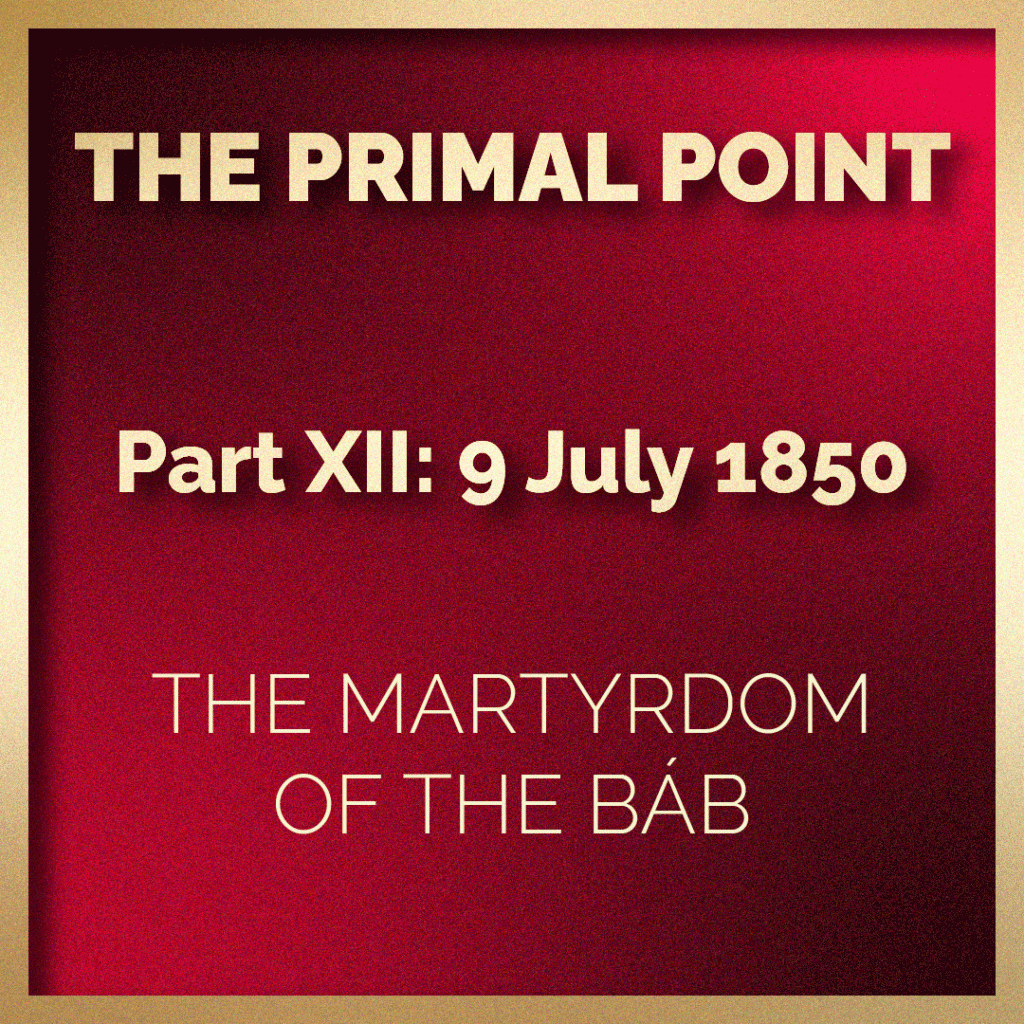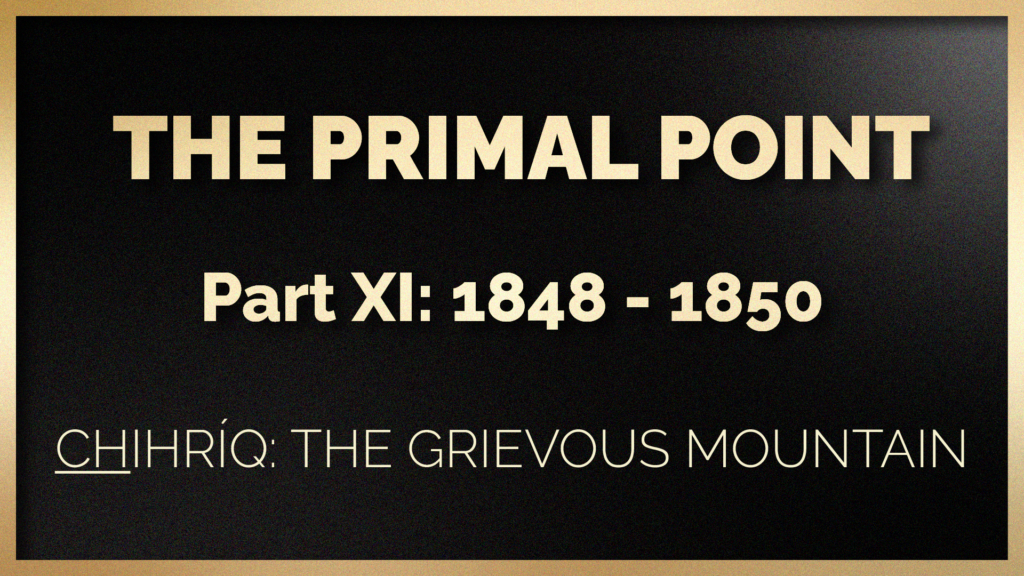
Written and illustrated by Violetta Zein
This part covers the life of the Báb from the age of 29 in 1848 to the age of 31 in 1850.
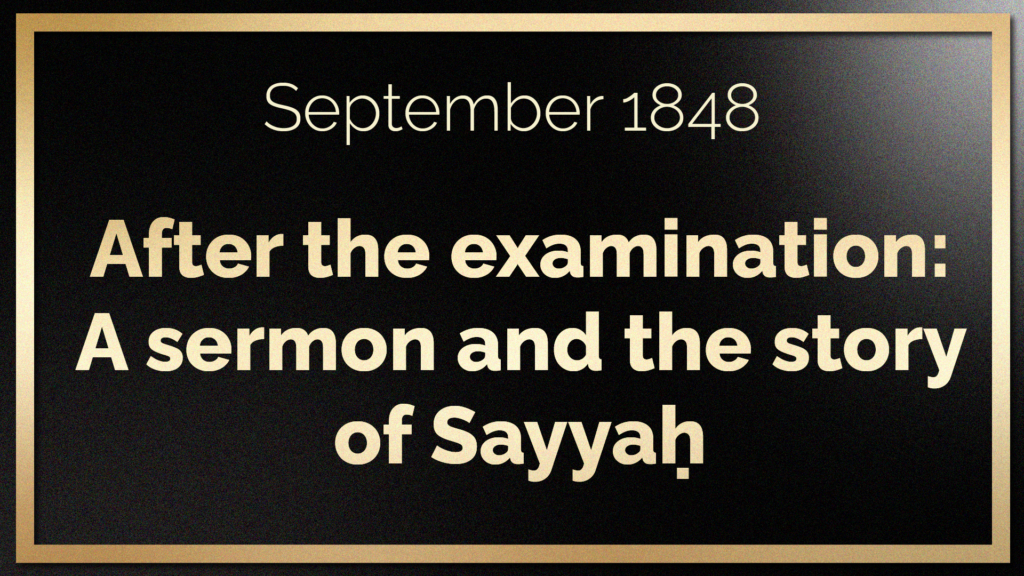

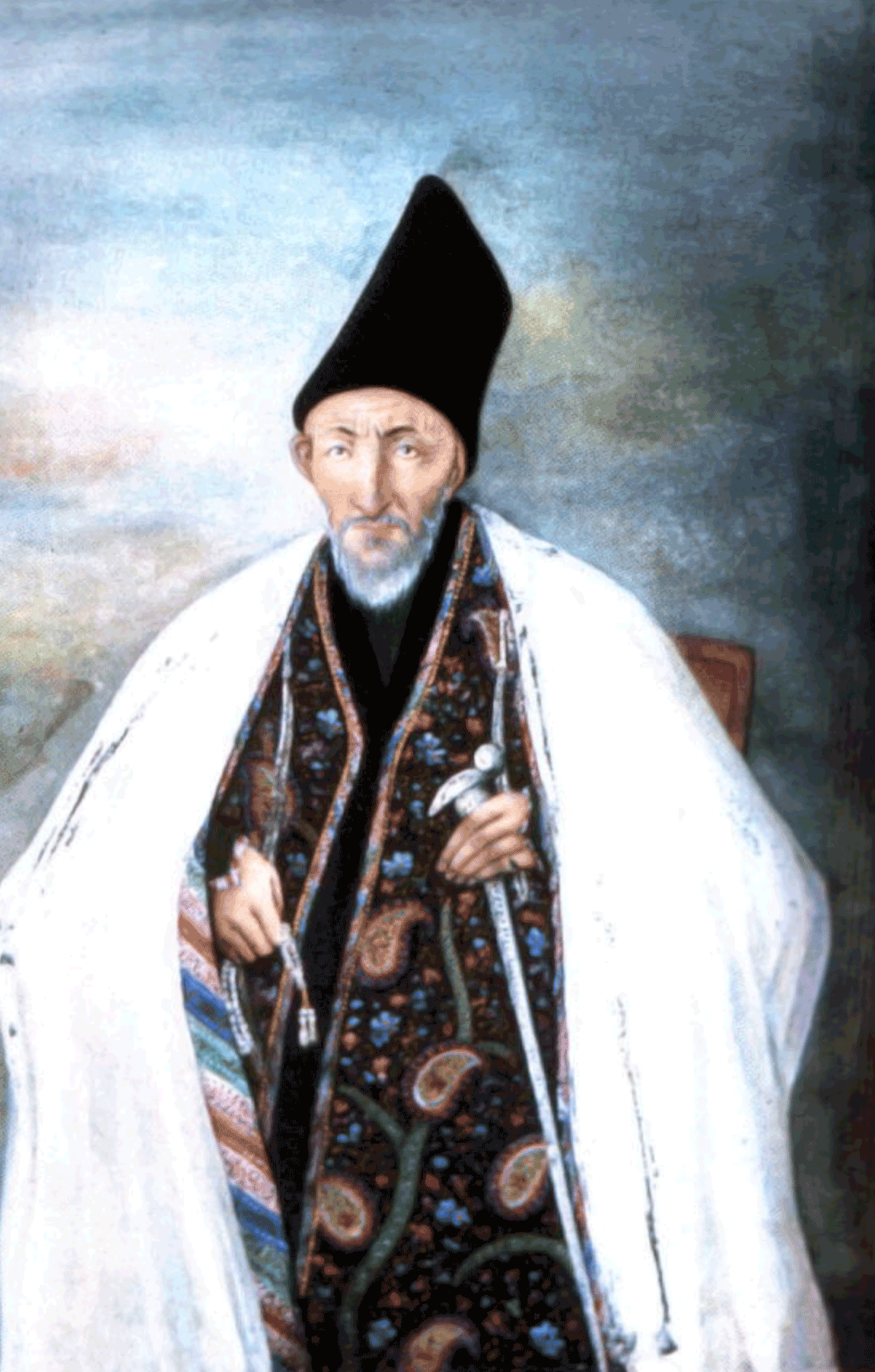
An 1846 portrait of Ḥájí Mírzá Áqásí, the Antichrist of the Bábí Revelation, two years before his death in 1848, the year he received his third Tablet from the Báb. The painting was done by Sani al Mulk, court painter. Source: Wikimedia Commons.
The Báb returned to Chihríq two months after His trial. As the trial took place at the end of July 1848, this would mean He returned to Chihríq sometime in September 1848.
Upon His return, the Báb revealed a weighty, severe Tablet to Ḥájí Mírzá Áqásí known as the Khuṭbiy-i-Qahríyyih (Sermon of Wrath, also known as the Epistle to Ḥájí Mírzá Áqásí), denouncing in moving language his character and his actions, and which began with the words:
“O thou who hast disbelieved in God, and hast turned thy face away from His signs!”
The three-page, unsparing Tablet was forwarded to Ḥujjat in Ṭihrán, who had the instructions to deliver it in person to Ḥájí Mírzá Áqásí. By that time, Ḥájí Mírzá Áqásí had fallen from power.
The Báb also revealed a Tablet for the ‘ulamás of Tabríz, calling on them to remove the veils of ignorance and prejudice that covered their eyes and understand the truth of His Cause.
In that Tablet, the Báb reminded the clerics that His Faith had done nothing but grow from its inception, and that nothing would ever halt its progress, and He reminded them that every criticism they raised against the Bábí religion was applicable to Islám, and that rejecting it was tantamount to rejecting Islám.
Partial Inventory ID: BB00074
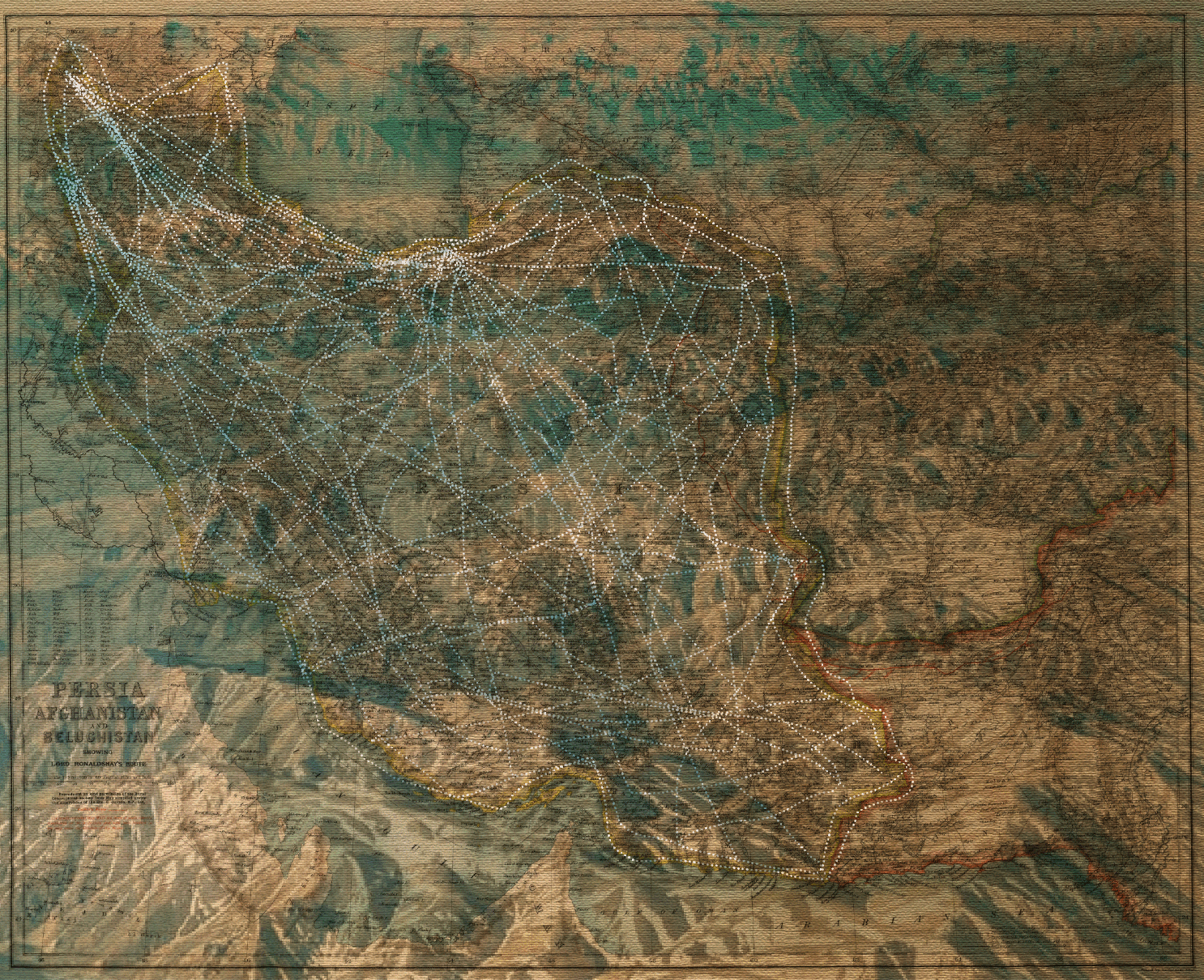
“Footsteps through Persia”: A tribute to Sayyaḥ’s immense service to the Báb in the form of a symbolic map of his footsteps throughout Persia (not based on historical data, it is an artistic interpretation), on the background of a 19th century map of Persia. Overlaid on the top of the design is an aerial photograph of the mountains of Wester Ádhirbáyján, where Sayyaḥ was born. © Violetta Zein
Mullá Ádí Guzal, also known as Mírzá ‘Alíy-i-Sayyaḥ (Traveller) was a native of Ádhirbáyján, and served as the Báb’s courier during His imprisonment. He was the means by which the Báb could be in constant communication with His followers throughout Persia.
He also served as the Báb's personal attendant for two months in the castle of Chihríq.
Mírzá ‘Alíy-i-Sayyaḥ walked thousands of kilometers to deliver the Báb’s Tablets and packages, and was well-known and revered by the Bábí community. When he arrived at Bahá'u'lláh’s home in Ṭihrán in 1848, shortly before the conference of Badasht, Vaḥíd bent low and kissed the feet of the man who had been in the presence of the Báb.
On one of his journeys, Mírzá ‘Alíy-i-Sayyaḥ delivered the Báb’s green silk turban to Mullá Ḥusayn before the uprising at Shaykh Ṭabarsí.
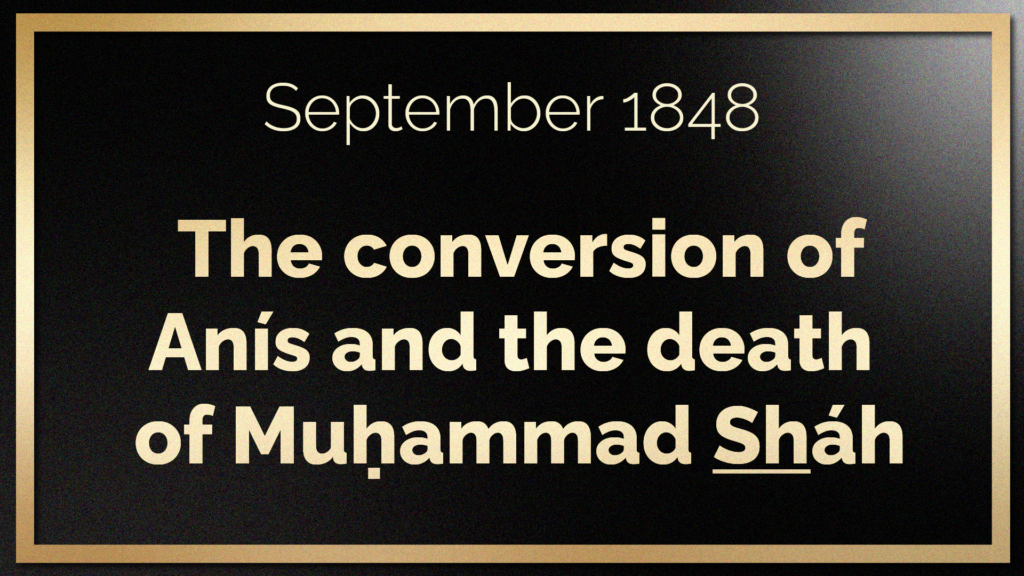
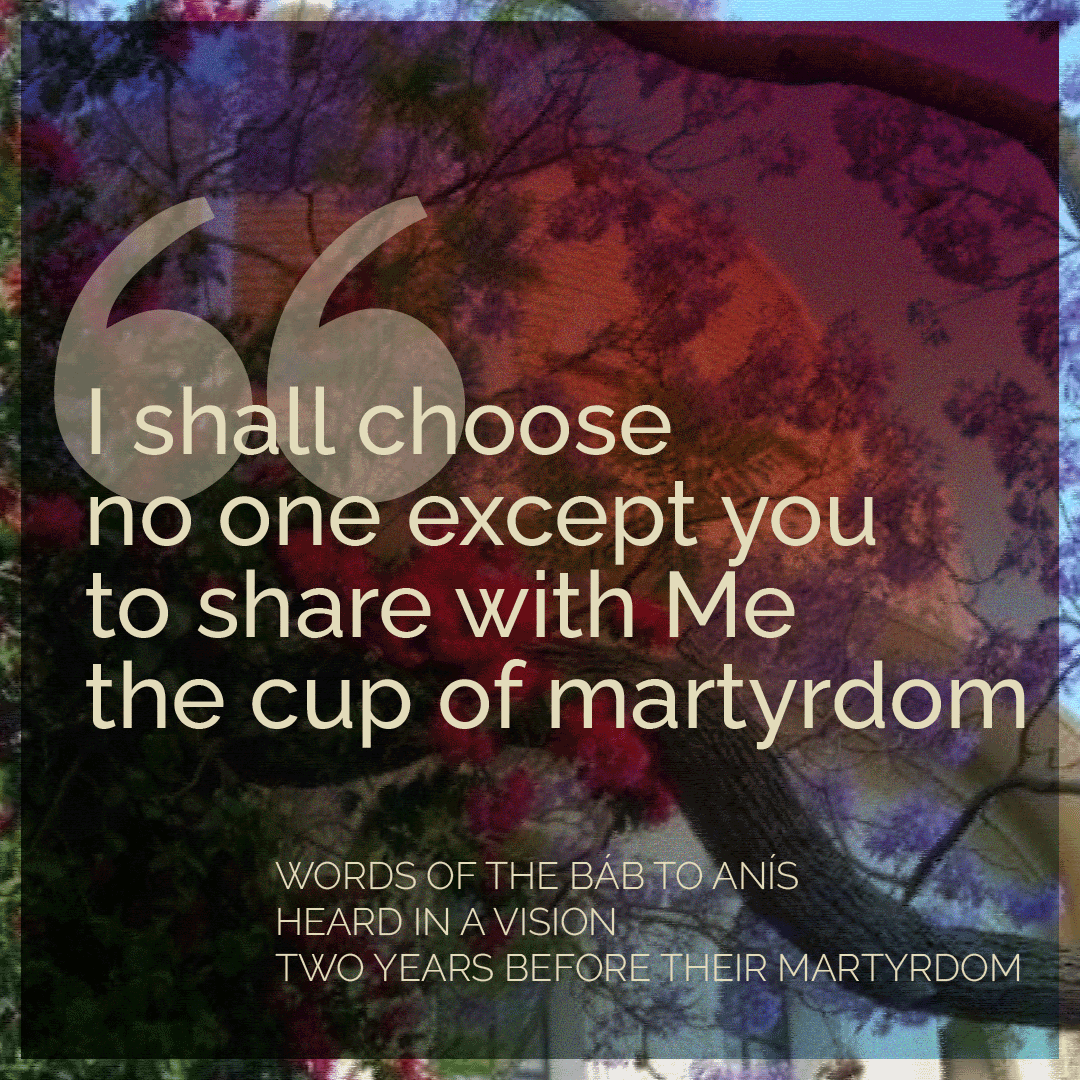
“No one except you”: The Shrine of the Báb seen through the intertwined jacaranda and bougainvillea trees, reminiscent of the Báb and Anís’ intertwined martyrdom two years from the time of this story. © Violetta Zein
Mírzá Muḥammad-‘Alíy-i-Zunúzí, known as Anís, was a relative of the Báb’s longtime faithful disciple and companion, Shaykh Ḥasan-i-Zunúzí. He had been devoted to the Báb for a long time but his stepfather had tried everything he could think of to prevent Anís from meeting the Báb, going so far as to lock him up in their house.
One day, when Shaykh Ḥasan-i-Zunúzí was visiting Anís, he found his young relative completely transformed. Anís was no longer despondent, but rather happy and at peace, and he told Shaykh Ḥasan-i-Zunúzí:
“The eyes of my Beloved, have beheld this face, and these eyes have gazed upon His countenance.”
Anís had seen the Báb in a vision after the Báb had returned to Chihríq from His examination in Tabríz and recounted to Shaykh Ḥasan-i-Zunúzí the secret of his happiness. As he lay in his cell, locked in by his stepfather, he turned his heart to the Báb and beseeched Him, saying:
“Thou beholdest, O my Best-Beloved, my captivity and helplessness, and knowest how eagerly I yearn to look upon Thy face. Dispel the gloom that oppresses my heart, with the light of Thy countenance.”
Anís had cried tears of agonizing pain, and was so overcome with emotion, he lost consciousness. Suddenly he heard the voice of the Báb calling to him, and summoning him to rise up. Anís saw the majesty of the Báb’s countenance, standing before him, smiling as He spoke these words, looking into Anís’ eyes, who rushed forward and threw himself at the Báb’s feet:
“Rejoice, the hour is approaching when, in this very city, I shall be suspended before the eyes of the multitude and shall fall a victim to the fire of the enemy. I shall choose no one except you to share with Me the cup of martyrdom. Rest assured that this promise which I give you shall be fulfilled.”
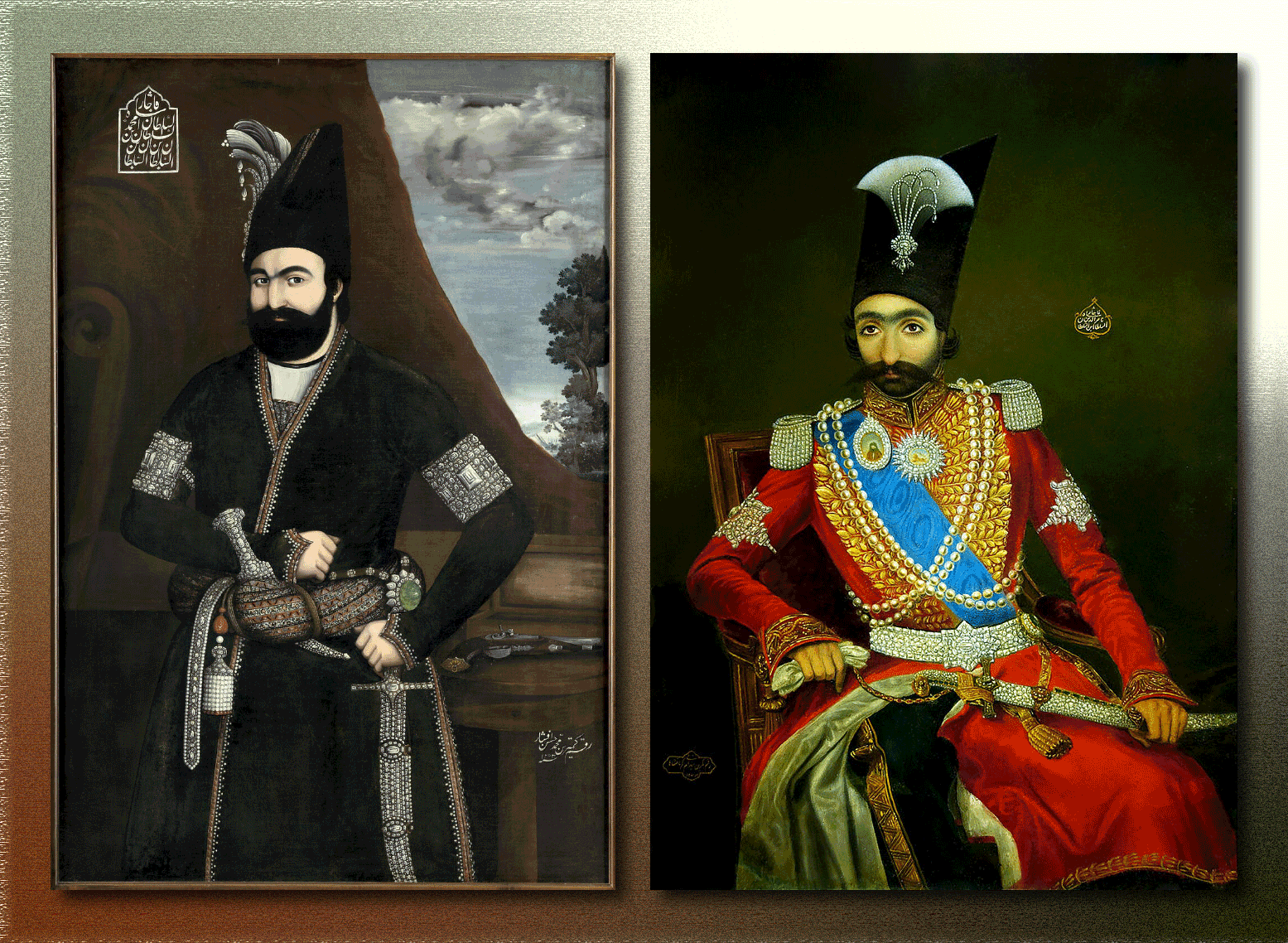
Muḥammad Sháh (left) died on 4 September 1848, and Naṣiri'd-Dín Sháh, 17, became the Sháh of Persia. Sources for the image of Muḥammad Sháh: Portrait of MohMuḥammad Sháh, offered to King Louis Phillippe I in 1839 by Mirza Hossein Khan (Wikimedia Commons).Image of Naṣiri'd-Dín Sháh: 1857 portrait of Naṣiri'd-Dín Sháh from the Louvre museum (Wikimedia Commons)
Muḥammad Sháh died on 4 September 1848, and the inexperienced Naṣiri'd-Dín Sháh, who had presided over the Báb’s mock trial in Tabríz, ascended the throne.
The death of Muḥammad Sháh, following the downfall of Ḥájí Mírzá Áqásí were events of far reaching consequence.
Naṣiri'd-Dín Sháh, the new monarch, was very young and inexperienced, and he was shadowed by the stubborn and willful Mírzá Taqí Khán (also known as the Amír-Niẓám and Amír-i-Kabír). Mr. Balyuzi has an elegant phrase for the relationship between the young Sháh and his prime minister:
“Although Náṣiri'd-Dín Sháh now reigned over Írán, it was Mírzá Taqí Khán who ruled it.”

During His incarceration in Chihríq, between April 1848 and July 1850, the Báb revealed a Tablet in honor of Mullá Báqir—the Thirteenth Letter of the Living—in which He expounds upon the majesty of the Promised One of the Bábí Dispensation (Bahá'u'lláh), one of the Báb’s recurring themes in this third stage of His Revelation.
In this Tablet, the Báb discusses the appropriate method to employ in approaching His claim and Revelation and emphasizes that the Promised One should be recognized by Himself:
“Beware, beware lest, in the days of His Revelation, the Vaḥíd of the Bayán shut thee not out as by a veil from Him, inasmuch as this Vaḥíd is but a creature in His sight. And beware, beware that the words sent down in the Bayán shut thee not out as by a veil from Him, inasmuch as these are His own words in His former Manifestation. He is the Sun of Truth, the Face of Unity, the Countenance of Lordship, the Inmost Reality of Divinity, and the Self of Eternity.”
Another statement of note in the Báb’s Tablet to Mullá Báqir are clear instructions He gives regarding verses to be recited before one can even mention the name of the Promised One and a precise prophecy He gives the Letter of the Living regarding the appearance of Bahá'u'lláh in the year 8 and by the beginning of the year 9:
“Count the numerical value of the letters of affirmation, including the tashdíd of the letter Lám, that haply thou mayest in eight years, in the day of His Revelation, attain unto His Presence.”
The most important aspect of the Báb’s Tablet to Mullá Báqir, however, lies in the fact that it can be considered, as Dr. Nader Saiedi states, as being the mystical and theological will and testament of the Báb.
This Tablet was sent to both Mullá Báqir and Vaḥíd, after he had asked the same question as the Letter of the Living.
The Báb spoke about the importance of this Tablet in clear terms in a Tablet He wrote to Aḥmad-i-Azghandí:
“I have revealed a book on the exaltation of His mention. Ye all must possess it, for God hath not revealed any tablet more glorious than that.How can one be considered amongst those who eagerly await the Day of His revelation if he fail to possess a copy thereof?”
In answer to Mullá Báqir and Vaḥíd’s questions regarding the advent of “Him Whom God shall make manifest,” the Báb speaks of their mutual stations:
“I have written down in My mention of Him these gem-like words: “No allusion of Mine can allude unto Him, neither anything mentioned in the Bayán.” Yea, By His glory! Those words are, before God, far mightier than all the deeds of worship of all who dwell on earth, inasmuch as the essence of all those deeds returneth unto the import of those same words. Therefore, recognize thou Him Whom God shall make manifest by the same testimony by which thou hast recognized God. For, exalted and glorified is He above the power of any one to reveal Him except Himself, or the description of any of His creatures. I Myself am but the first servant to believe in Him and in His signs, and to partake of the sweet savors of His words from the first-fruits of the Paradise of His knowledge.”
For an in-depth analysis of this Tablet, please see Nader Saiedi, Gate of the Heart: Understanding the Writings of the Báb, pages 371-374.
Partial Inventory ID: BB00078
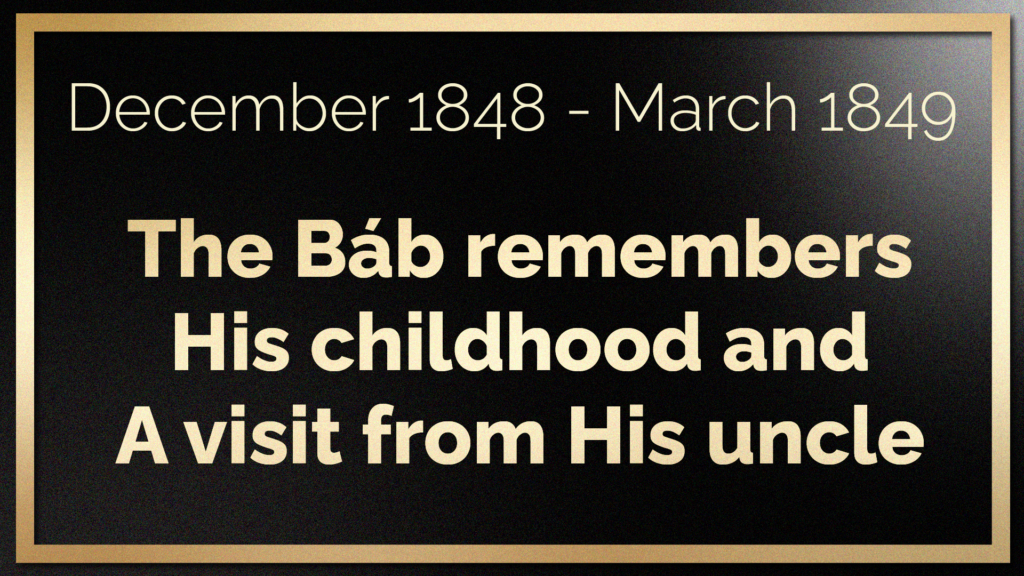

The Kitáb-i-Sí Du’á (The Book of Thirty Prayers), is a new discovery among the Writings of the Báb. It is a book of around 300-400 pages, comprising 30 prayers each celebrating one year of His Life, in celebration of His 30th birthday, and revealed in Chihríq in the span of 30 days between December 1848 and January 1849.
The Báb dedicated each prayer to one year of His life, and therefore constitutes, in the words of Nader Saiedi, a “spiritual autobiography” of sorts, as the overarching theme of the Kitáb-i-Sí Du’á is communion with God.
It is in this compilation of prayers that the Báb repeatedly asks blessings for “he who raised Me,” His servant from childhood, who had begun his life as a slave, Ḥájí Mubárak, something deeply obvious in prayer number 7, dedicated to the Báb’s seventh year:
“Send down, then, upon me, O my God, when I was seven years old and upon him who raised me on Thy behalf, whose name is Mubárak, that which beseemeth the splendours of the sanctity of Thy loftiness and the wonders of the might of Thy revelation.”
It is deeply to touching to see the Báb remember so often Ḥájí Mubárak during His imprisonment in the mountains of Ádhirbáyján both in prayers revealed in his honor but also mentioned in letters He addresses to His mother, Fáṭimih Bagum.
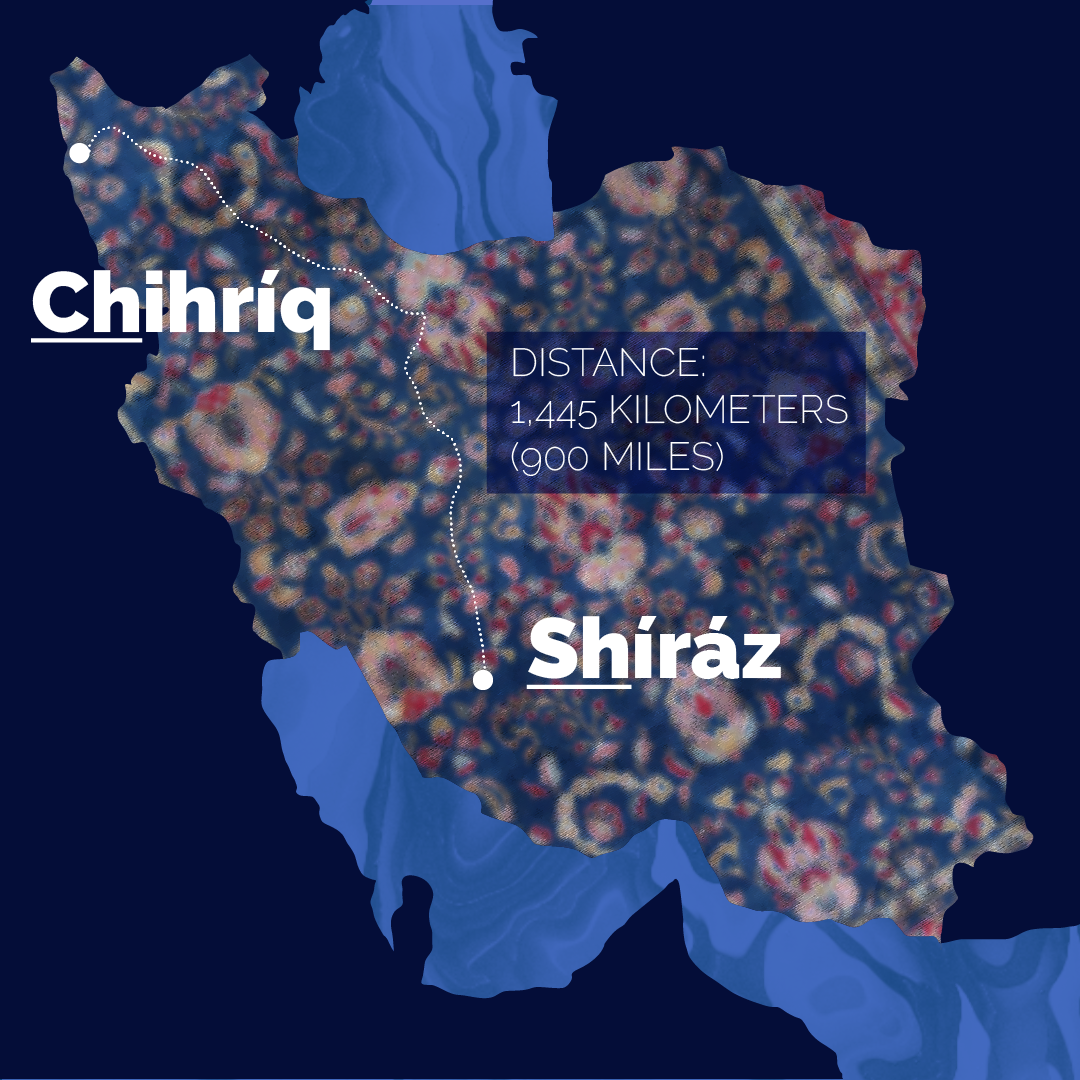
Map of the most probably journey from Shíráz to Chihríq: through Iṣfahán to Ṭihrán, and north of Lake Urúmíyyih, via Khúy. The total distance would have been close to 1,445 kilometers (nearly 900 miles). Background of the map is an antique Persian carpet © Violetta Zein
During the last months of the Báb’s life, He received the visit of His beloved and faithful uncle, Ḥájí Mírzá Siyyid ‘Alí, two years after they last saw each other in Shíráz.
Ḥájí Mírzá Siyyid `Alí could no longer bear the separation with the Báb, and had settled his accounts, closed his books and traveled to Ádhirbáyján.
After seeing the Báb, Ḥájí Mírzá Siyyid ‘Alí wrote a letter to his brother, Ḥájí Mírzá Siyyid Muḥammad dated 30 March 1849, on the fifth anniversary of the Declaration of the Báb, on the fifth day of the fifth month of the Islamic calendar, to try and help his brother see the truth of the Báb’s mission:
On such a day, the resplendent Light of God shone forth.... This is the day of Resurrection ... the day to behold the Visage of God.”
Ḥájí Mírzá Siyyid ‘Alí, deeply enkindled, was helping his brother see that the Promised One, awaited for a thousand years, had finally come and brought Holy Writings that were the essential truth of any Manifestation of God. Ḥájí Mírzá Siyyid ‘Alí asked that the whole family read this letter.
For the Báb also, this visit must have brought Him great joy, as Ḥájí Mírzá Siyyid ‘Alí had been His protector since His early childhood.
Beyond that, the bond between the uncle and his Nephew transcended blood, as Ḥájí Mírzá Siyyid ‘Alí never wavered in his belief in the Báb, until his own martyrdom.
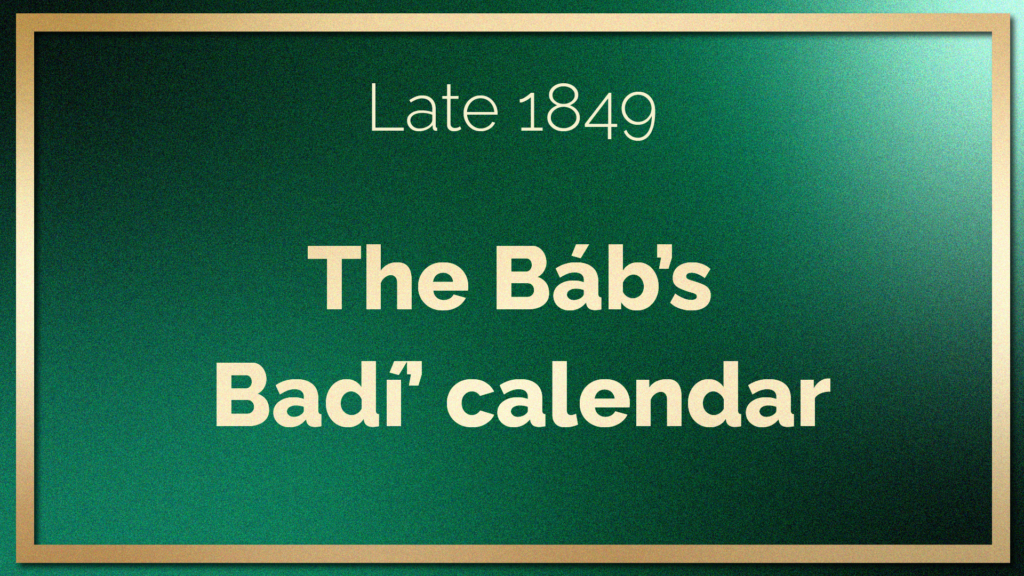

In the last few months of His life, the Báb instituted a new calendar for the Bahá'í Dispensation, which He called the Badí’ (Wondrous) calendar, which is the calendar all Bahá'ís use today to mark the passing of time, and celebrate Feasts and Holy Days.
The Báb referenced this calendar in two of His writings during this period, the Persian Bayán (Vaḥíd 5, Chapter 3) and the Kitábu’l-Asmá’.
As with many of the Báb’s new laws in this third and legislative stage of His Revelation, the new calendar was a revolutionary act and, as a final break with Islám and its lunar calendar, He instituted a solar calendar for this new Dispensation.
With the Badí’ calendar, the Báb transformed our understanding of time, spiritualizing the entire concept of days, months, years, cycles, and time. As Dr. Saiedi says in Gate of the Heart:
“Time becomes literally filled with God.”

“361”: A symbolic representation of the 19 months of 19 days of the Badí’ calendar, using assets created in the AI Midjourney (tiles of Persian illumination style). © Violetta Zein
The Báb organized time symbolically in His calendar. The 19 months of 19 days, equaling 361 days equal the numerical value of the words “all things” (“kullu shay”). The Kitábu’l-Asmá’, in which the Báb lays out the characteristics of the Badí’ calendar is composed itself of 19 Vaḥíds of 19 gates, for a total of 361 gates.
With this numerical perfection, the Báb intended for all things traversing this perfect calendar of 19 months of 19 days in a single year, that they would traverse all 19 stages of the Letters of Unity.
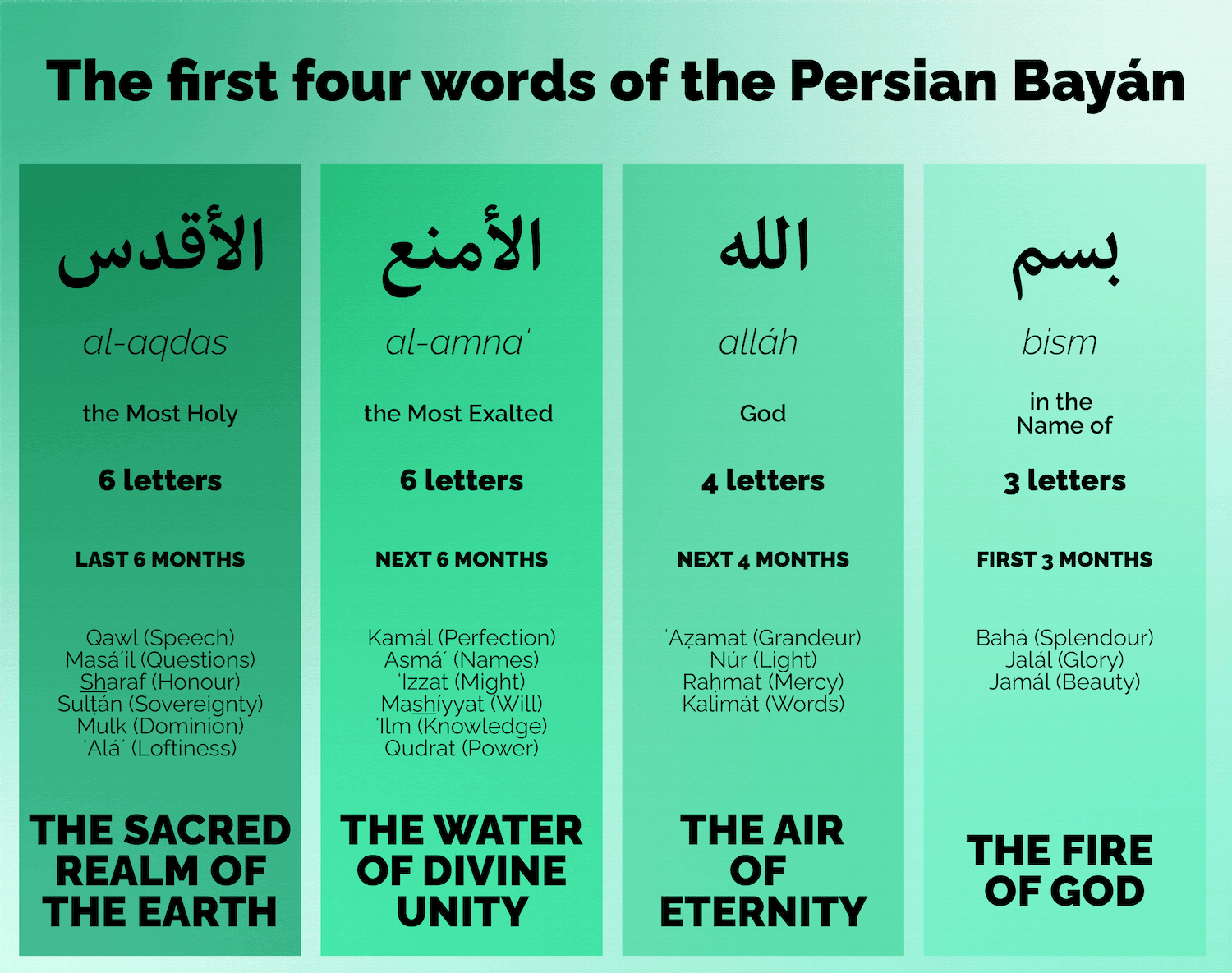
“The first four words”: Infographic of the underlying spiritual structure of the Badí’ calendar showing the four opening words of the Persian Bayán, their transliteration, English translation, and the corresponding unities of months to the number of their letters with their respective realms, as explained in the story below. Many thanks to Adib Masumian for providing the Arabic typescript, transliteration and translation of the opening words of the Bayán. © Violetta Zein
The entire underlying spiritual structure of the calendar is spiritually profound, and extremely intricate. The 19 months of the Badí’ calendar correspond to the four words of the opening phrase of the Persian Bayán. These four words are:
- bism = in the Name of (three letters in Arabic: بسم)
- alláh = God (four letters in Arabic: الله)
- al-amnaʻ = the Most Exalted (six letters in Arabic: الأمنع)
- al-aqdas = the Most Holy (six letters in Arabic: الأقدس)
The 19 months of the Badí’ calendar are divided into four units representing a spiritual element, according to these first opening words of the Persian Bayán:
- A first unit of 3 months for the 3 letters of the first word representing the fire of God;
- A second unit of 4 months for the 4 letters of the second word representing the air of eternity;
- A third unit of 6 months for the 6 letters of the third word representing the water of Divine Unity;
- And a fourth unit of 6 months for the 6 letters of the fourth opening word representing the sacred realm of the earth.
The Báb intended for these four divisions, drawn from the first four words of the Persian Bayán to represent as Dr. Saiedi says, “the four layers of the divine covenant, the four words of divine praise, and the four creative names of God.”
In the rest of the calendar, spirituality elevates everything. Each detail of the calendar is imbued with meaning. Each of the 19 months in the Badí’ calendar, and each of the 19 days within that month both bear the name of one of the 19 attributes of God:
- Bahá بهاء (Splendour)
- Jalál جلال (Glory)
- Jamál جمال (Beauty)
- ʻAẓamat عظمة (Grandeur)
- Núr نور (Light)
- Raḥmat رحمة (Mercy)
- Kalimát كلمات (Words)
- Kamál كمال (Perfection)
- Asmáʼ اسماء (Names)
- ʻIzzat عزة (Might)
- Mas͟híyyat مشية (Will)
- ʻIlm علم (Knowledge)
- Qudrat قدرة (Power)
- Qawl قول (Speech)
- Masáʼil مسائل (Questions)
- S͟haraf شرف (Honour)
- Sulṭán سلطان (Sovereignty)
- Mulk ملك (Dominion)
- ʻAláʼ علاء (Loftiness)
The four or five intercalary days left over in the calendar are called Ayyám-i-Há, the days of Há. The calendar was later formalized by Nabíl, author of the Dawb-Breakers, who followed Bahá'u'lláh’s instructions based on the Báb’s initial design.
To end on a modern, scientific note, it is interesting to note that the Badí’ calendar, which the Báb based on the square root of the annual cycle (19 months of 19 days) is the most symmetrical time relationship between days and months of any calendar in history.
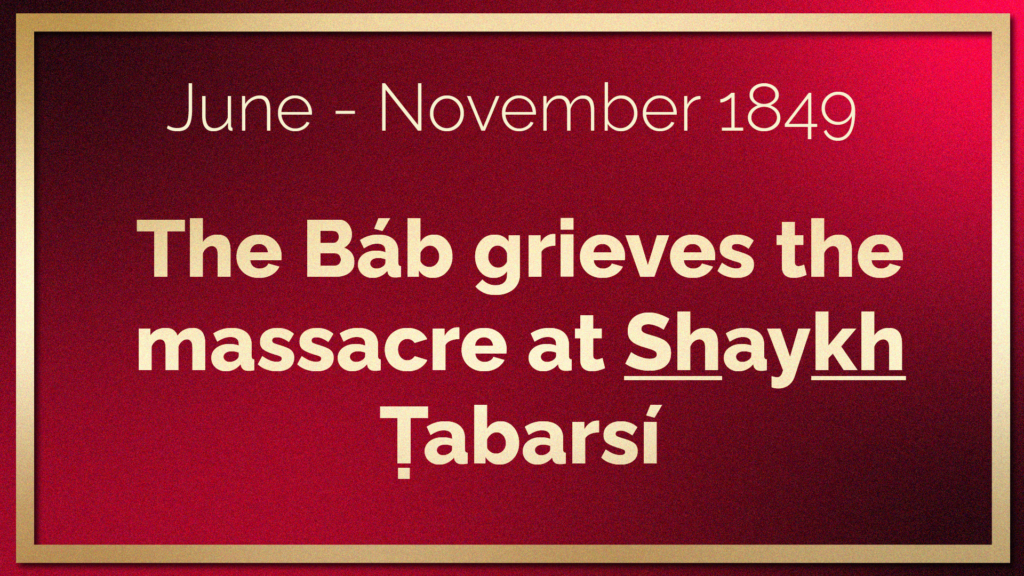
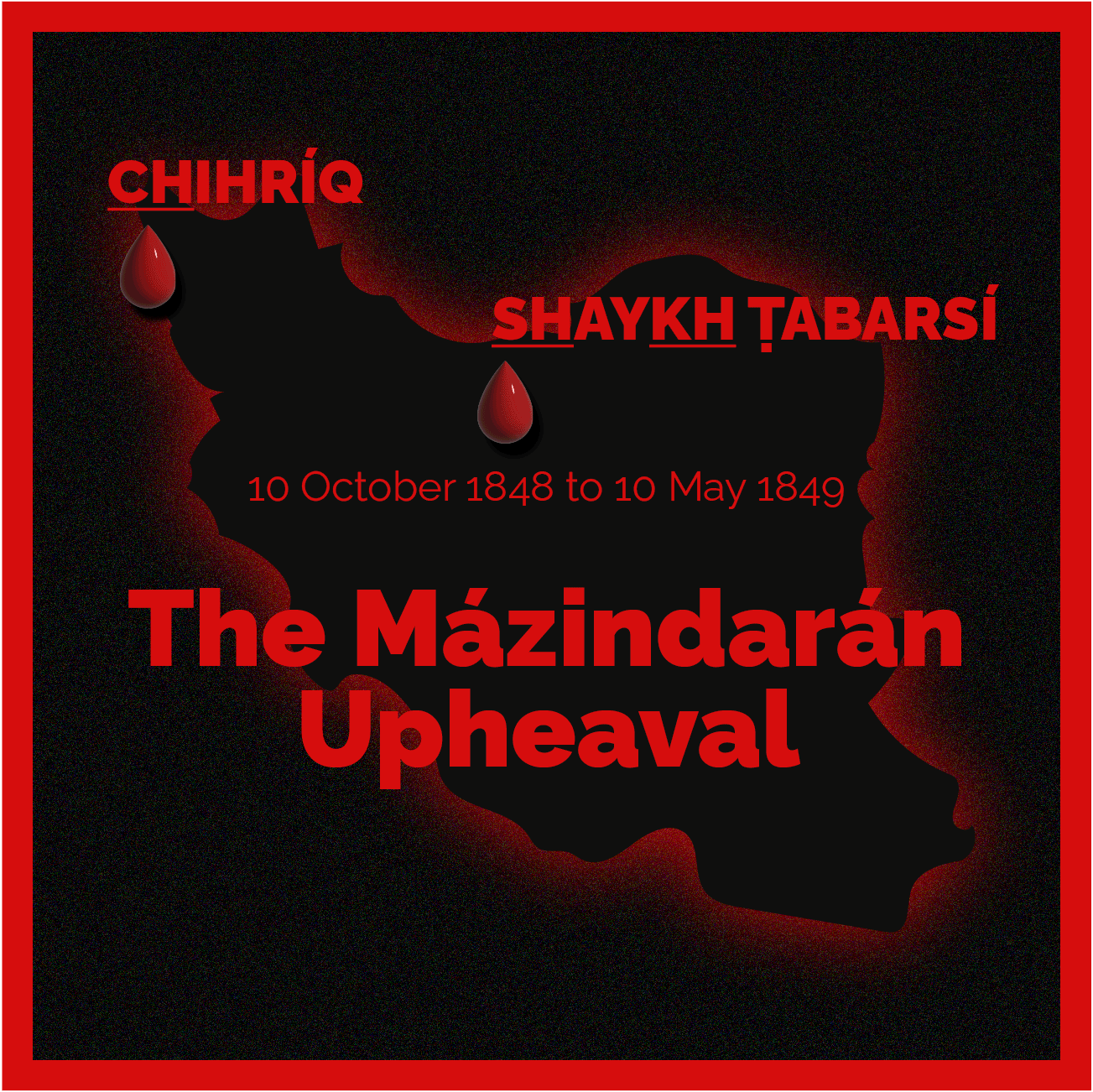
Map showing where the Fort of Shaykh Ṭabarsí is located in relation to Chihríq, where the Báb was when He received the devastating news. © Violetta Zein
Around the end of June 1849, a few months after Ḥájí Mírzá Siyyid ‘Alí’s visit, the Báb received the devastating news of the massacre at Shaykh Ṭabarsí, where a 450 Bábís were brutally killed in a siege that ended on 10 May 1849.
Among the martyrs of this first uprising were nine Letters of the Living:
- The Eighteenth Letter of the Living: Quddús, who had accompanied the Báb on His pilgrimage to Mecca and Medina, and first in rank among all the Letters of the Living;
- The First Letter of the Living: Mullá Ḥusayn, the first to believe in the Báb;
- The Second Letter of the Living: Mírzá Muḥammad-Ḥasan-i-Bushrú’í;
- The Third Letter of the Living: Mírzá Muhammad Báqir-i-Bushrú’í;
- The Tenth Letter of the Living: Mullá Maḥmúd-i-Khú’í;
- The Eleventh Letter of the Living: Mullá Jalíl-i-Urúmí;
- The Twelfth Letter of the Living: Mullá Aḥmad-i-Ibdal-i-Marághi’í;
- The Fourteenth Letter of the Living: Mullá Yúsuf-i-Ardibílí;
- The Sixteenth Letter of the Living: Mírzá Muḥammad-‘Alíy-i-Qazvíní.
When the Báb heard, in detail, about the endless trials that had beset Quddús and Mullá Ḥusayn, the agonies suffered by the Bábís besieged in Shaykh Ṭabarsí, how the survivors of the upheaval were so cruelly and shamelessly betrayed, the sufferings that they endured, and the abominations that were visited on their corpses, He was crushed with grief.
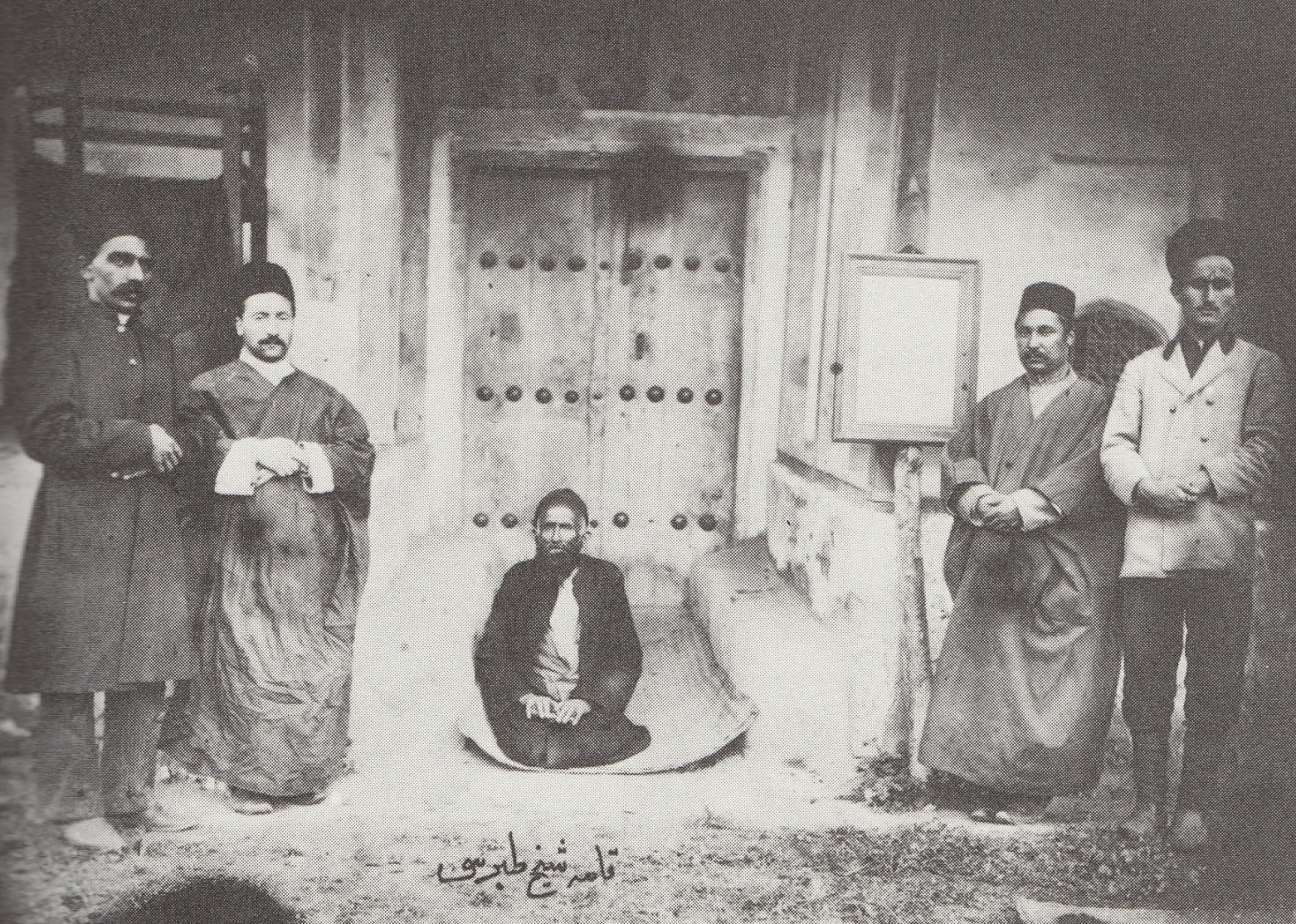
Entrance to the Shrine of Shaykh Ṭabarsí. Source: Nabíl, The Dawn-Breakers, page 346.
Heart-broken, the Báb plunged into a state of unbearable sorrow, for nine days, the grief from this devastating tragedy stilled the Báb’s voice and He put a stop to Revelation, refusing to meet any of His followers, not even His personal attendant or amanuensis.
For nine days, the Báb refused to eat or drink, and tears streamed from His blessed face continually, and He constantly expressed His anguish, giving voice to His immense sadness as He communed with God in the privacy of His prison cell.
For five months, from June to November 1849, the Báb could neither write nor dictate and He languished, solitary and inconsolable, in His prison.
When His amanuensis began to note down the words of sadness that were streaming from His lips in an attempt to preserve His lamentations, the Báb ordered him to stop and destroy whatever he had recorded.
No other testimony or Writings remain for us today of the six months of agony the Báb experienced, or the cries of his sorrow-filled heart, except that of His attendants who recounted that He spent that time in immense pain and “languished, immersed in an ocean of despondency and sorrow.”

After five months had passed, the Báb began to reveal again, towards the end of November 1849. Not surprisingly, the first page He revealed was a Tablet of visitation in honor of Mullá Ḥusayn, the first to believe in Him.
In this Tablet, the Báb extolled in moving terms Mullá Ḥusayn’s unswerving loyalty to Quddús during the siege at Shaykh Ṭabarsí, He praised his shining and generous character, told of his many exploits and confirmed they would see each other in the next world.
The Báb also added, on a heart-breaking note, that he would soon join Mullá Ḥusayn and Quddús.
For a full week, the Báb continued to reveal eulogies in praise of Mullá Ḥusayn, Quddús. and other martyrs at Shaykh Ṭabarsí, which included the Sifter of Wheat He had mentioned in the Persian Bayán, a man named Mullá Ja’far.
Partial Inventory ID: BB00233
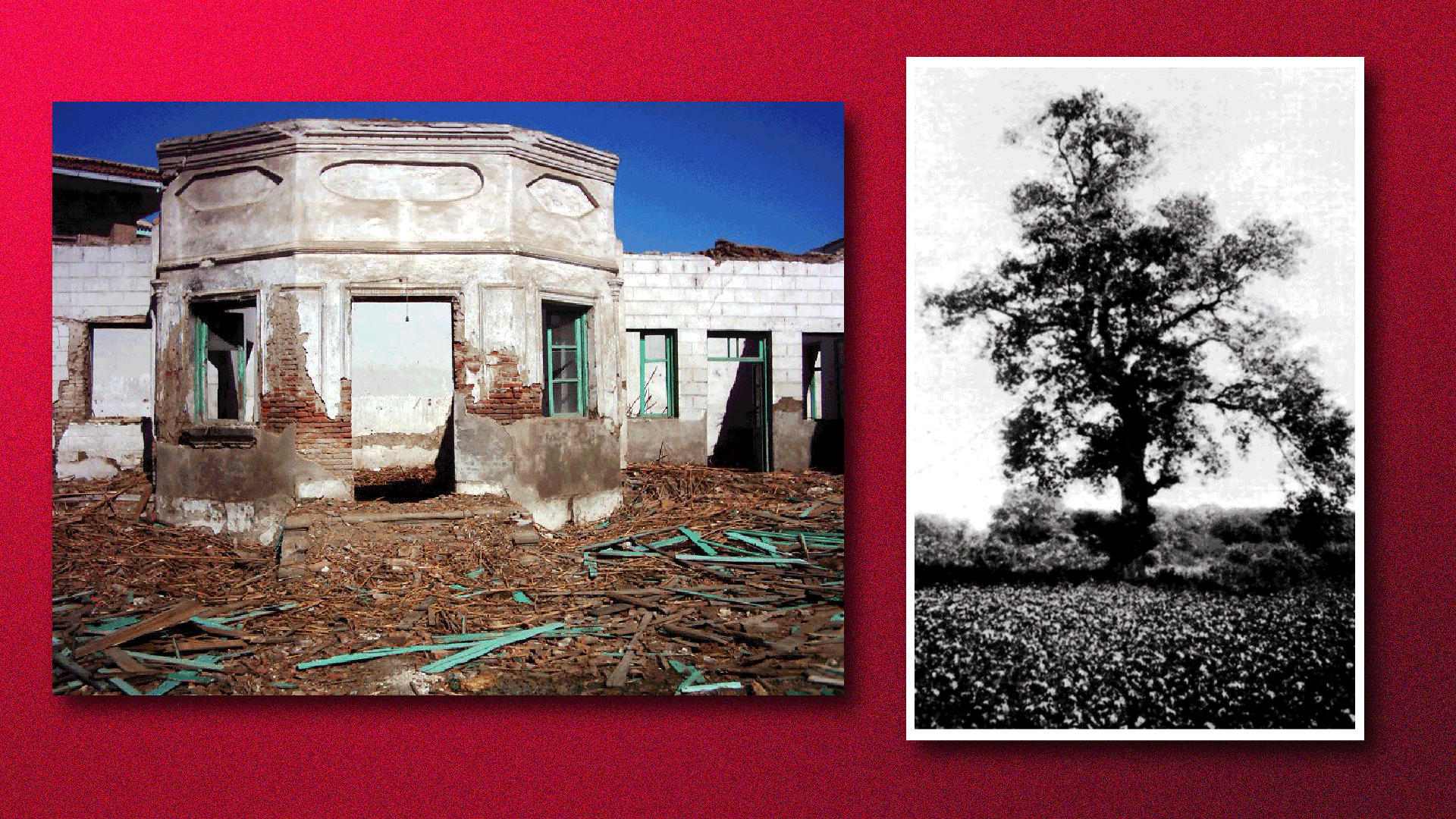
Left: Destroyed resting place of Quddús Source: Bahá'í World News Service. Right: Photograph of the tree from which Mullá Ḥusayn was shot. No photos of Mullá Ḥusayn’s resting place could be found, but Mullá Ḥusayn is buried in the grounds of the fort of Shaykh Ṭabarsí. Source: Nabil, The Dawn-Breakers, page 380.
Shortly after His period of five months of grief and sorrow over the massacre of Shaykh Ṭabarsí, the Báb sent Mírzá ‘Alíy-i-Sayyaḥ on a spiritual quest to make a pilgrimage to the graves of Mullá Ḥusayn and Quddús on His behalf.
The Báb would mourn both Quddús and Mullá Ḥusayn in unnumbered Tablets and prayers, eulogizing their virtues and lamenting their loss. In a prayer He revealed for Mullá Ḥusayn, the Báb affirms that the very dust of the ground where the remains of Mullá Husayn are interred is endowed with such potency as to bring joy to the disconsolate and healing to the sick.
It took Mírzá ‘Alíy-i-Sayyaḥ nearly a month and a half on foot to reach Mázindarán and carry out the Báb’s request. He arrived on 15 January 1850, and six days later, on 23 January 1850, he performed pilgrimage on the gravesite of Mullá Ḥusayn on behalf of the Báb.
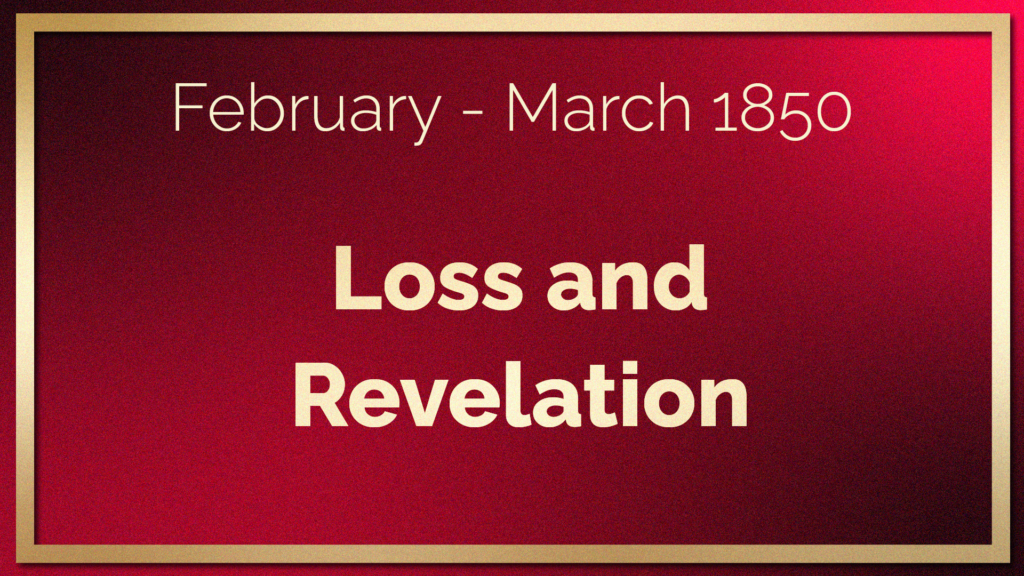
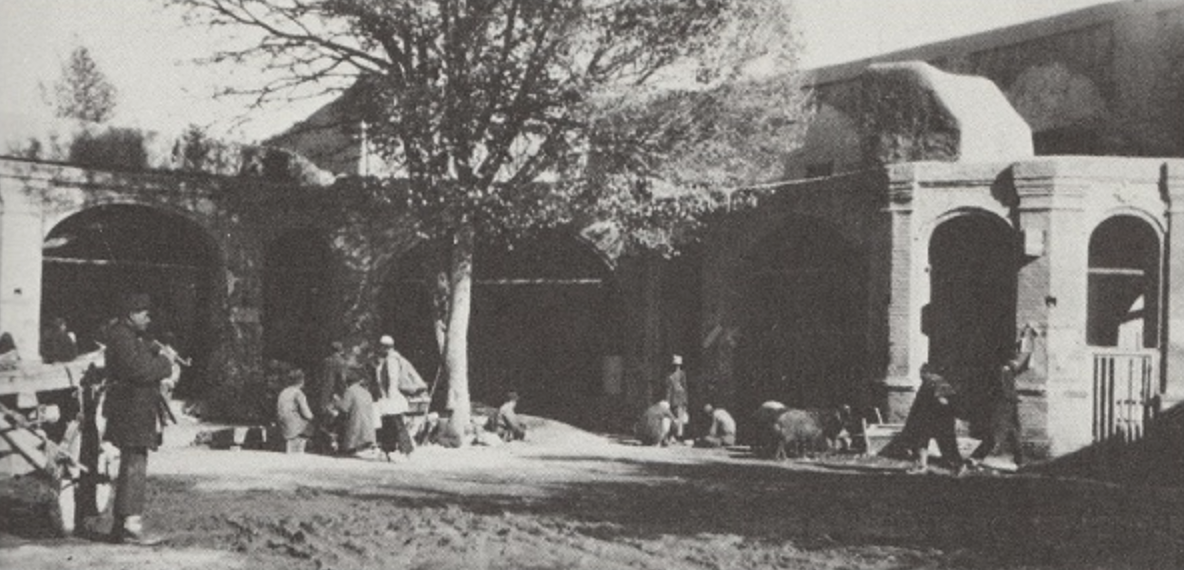
The Sabzih-Maydán of Ṭihrán where the Seven Martyrs of Ṭihrán were beheaded. Many other Bábís suffered martyrdom in this square. Nabíl, The Dawn-Breakers, page 457.
After leaving Chihríq, Ḥájí Mírzá Siyyid ‘Alí went to Ṭihrán, and, at the beginning of 1850, he was arrested along with six other Bábís, and charged with plotting to assassinate the Prime Minister.
The seven heroic souls were defiant in the face of the false accusations, and joyful in their approaching martyrdom. Some recited deeply touching verses, others addressed challenges to the masses who had come to see their deaths, in the public square and were hurling insults and throwing refuse at the faithful Bábís.
The Báb’s uncle was also a descendent of the Prophet Muḥammad and Mírzá Taqí Khán, reluctant to execute a Siyyid, had been offered a chance to save his own life if he recanted His faith in the Báb, his Nephew. His bold response to the Prime Minister’s poisoned offer was:
“Your Excellency, if others before me, who quaffed joyously the cup of martyrdom, have chosen to reject an appeal such as the one you now make to me, know of a certainty that I am no less eager to decline such a request. My repudiation of the truths enshrined in this Revelation would be tantamount to a rejection of all the Revelations that have preceded it. To refuse to acknowledge the Mission of the Siyyid-i-Báb would be to apostatise from the Faith of my forefathers and to deny the Divine character of the Message which Muhammad, Jesus, Moses, and all the Prophets of the past have revealed. God knows that whatever I have heard and read concerning the sayings and doings of those Messengers, I have been privileged to witness the same from this Youth, this beloved Kinsman of mine, from His earliest boyhood to this, the thirtieth year of His life. Everything in Him reminds me of His illustrious Ancestor and of the imáms of His Faith whose lives our recorded traditions have portrayed. I only request of you that you allow me to be the first to lay down my life in the path of my beloved Kinsman.”
The Báb, at the other end of the kingdom, in remote Chihríq had been overwhelmed in the previous months with calamity after calamity, hearing of the deaths of most of His Letters of the Living. Now, His beloved uncle had been martyred, and the Báb eulogized the Seven Martyrs of Ṭihrán, as the accomplishment of a Ḥadíth according to which seven creatures would be martyred before their shepherd, the promised Qá’im.
The Báb knew His own martyrdom was fast approaching, and He began to make preparations.

One of the very last major Holy Writings revealed by the Báb is the Kitáb-i-Panj Sha’n (The Book of the Five Modes of Revelation), four months before His martyrdom.
The Báb revealed the Kitáb-i-Panj-Sha’n starting on 19 March 1850. The Kitáb-i-Panj-Sha’n was revealed in 19 chapters, each dealing with the names of God, corresponding to the names of the first 19 days of the first month of Bahá in the Bahá'í calendar. The 19 days of each month, in the Bahá'í calendar, all have the same name, in the same order, as the 19 months, and are, therefore, the following:
Bahá (Splendour), Jalál (Glory). Jamál (Beauty), ʻAẓamat (Grandeur), Núr (Light), Raḥmat (Mercy), Kalimát (Words), Kamál (Perfection), Asmá’ (Names), ʻIzzat (Might), Mas͟híyyat (Will), ʻIlm (Knowledge), Qudrat (Power), Qawl (Speech), Masá’il (Questions), S͟haraf (Honour), Sulṭán (Sovereignty), Mulk (Dominion), ʻAlá’ (Loftiness)..
In the Kitáb-i-Panj-Sha’n, the Báb correlates these 19 names of God to the 19 figures of the first vaḥíd of Bábí Unity, and expounds on many fundamental spiritual concepts such as nearness to God, light, beauty, and unity.
Each of the 19 chapters of the Kitáb-i-Panj-Sha’n can be considered independent Tablets, and each of them was written in honor of one of the Bábís. The Tablet of Ḥurúfát (Tablet of the Nineteen Temples), is one of the chapters of the Kitáb-i-Panj-Sha’n.
Partial Inventory ID: BB00005
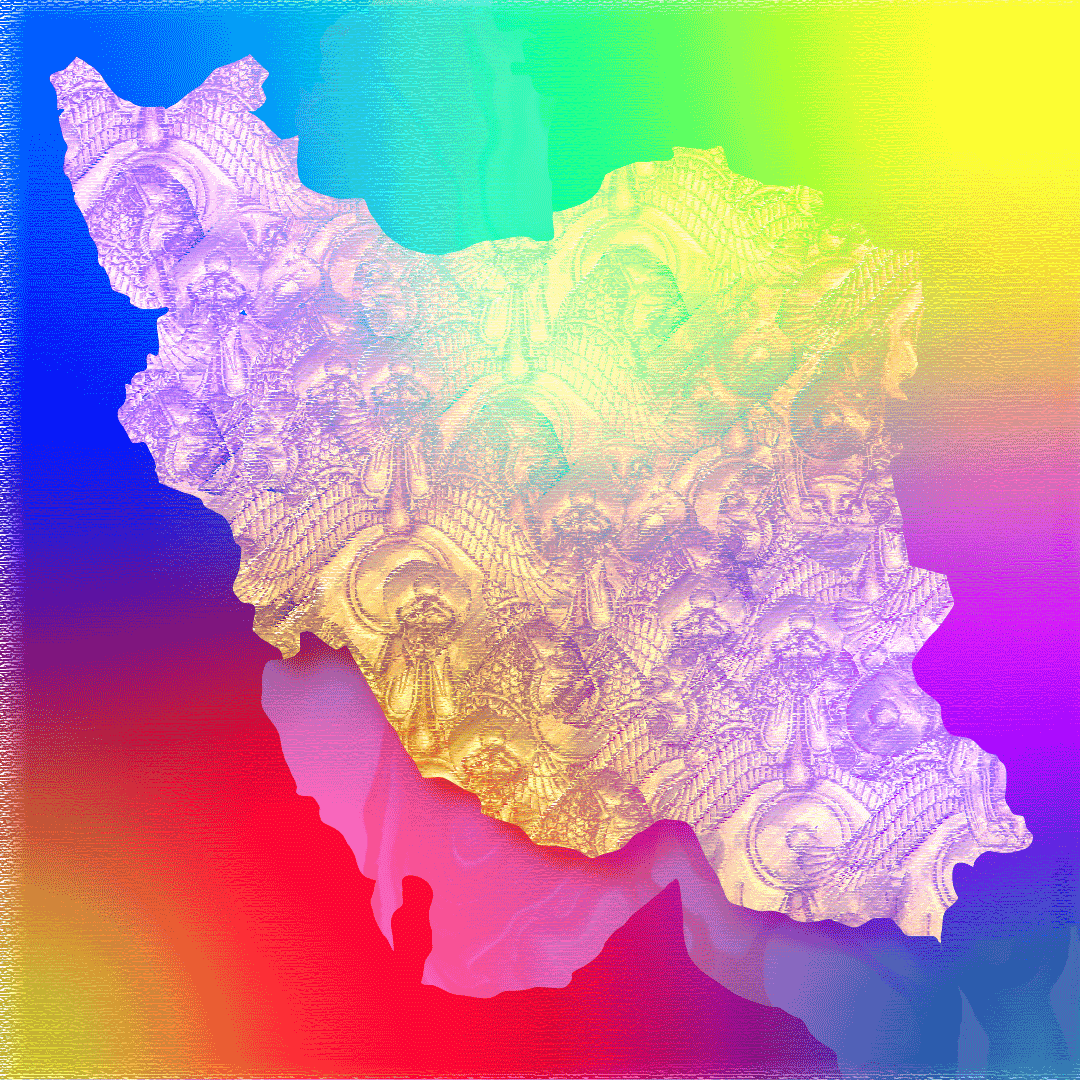
“Integrative mode”: An abstract representation of the fifth mode outlined by the Báb in the the Kitáb-i-Panj Sha’n, being the “integrative” mode, as the Báb could express the other four modes (divine verses, prayers, sermons and commentaries) in this fifth mode, a mode that differentiates the Bábí Revelation from the Islámic Dispensation, which only considered Arabic a language of Revelation. The five modes are represented by five colors in this graphic, and the map of Persia is embossed on a tiled detail from a gold plaque with horned lion-griffins, Achaemenid, 6th/4th century BCE from The Met. Design: © Violetta Zein
The Book of Five Modes is a large book of rhapsodies on the various names of God, rendered in the five literary registers, or “modes,” into which the Báb divided His own Writings:
- Divine verses (ayát)
- Prayers (munáját)
- Sermons (Khutbih)
- Commentaries (tafsír)
- Persian (fársí)
The mode of divine verses is the direct Revelation of God uttered in the voice of God addressing His creation.
The mode of prayers and supplications is the reverse of the mode of divine verses, in which the Báb speaks as a creation uttering His praises to God in a state of servitude.
The mode of sermons is an affirmation of the mode of divine verses, speaking to creation about God and His Revelation.
The mode of commentaries is in the same voice as the mode of sermons, but directed towards rational, analytical, educational, and philosophical discourse in order to show the signs of the unseen and examine the manifestations of the divine in creation.
The Persian mode center around the Báb’s introduction of Persian as a language of divine Revelation, in addition to Arabic, which is the only language of Revelation in Islám. The Báb considers His Persian Writings as a distinct mode of Revelation, but they can be found in each of the other modes: divine verses, prayers, sermons, or commentaries. Dr. Saeidi argues that the Persian mode in the Revelation of the Báb “represents an integrative form of the other four modes.”
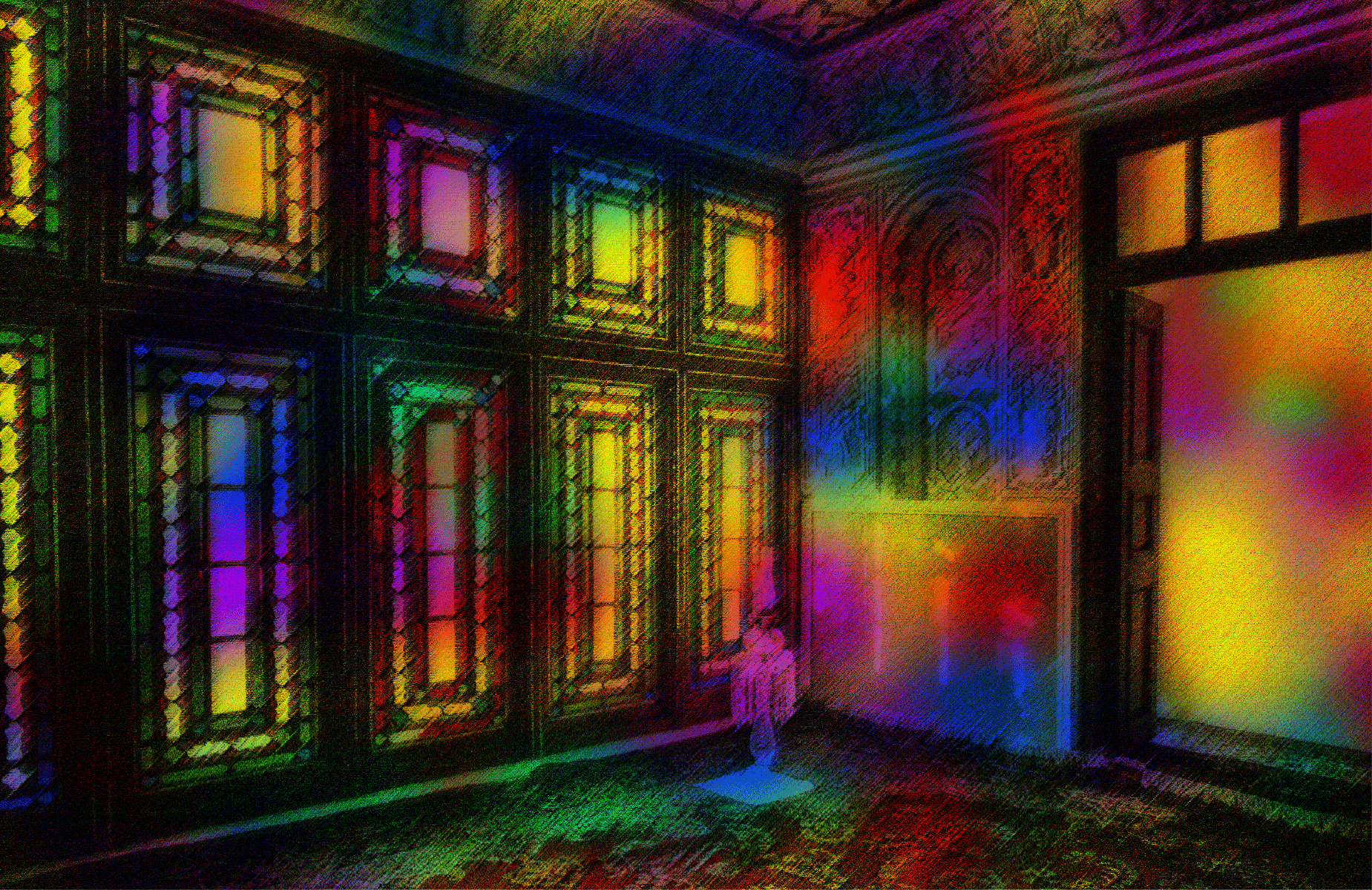
“Five modes”: For an excerpt from the Kitáb-i-Panj Sha’n (The Book of Five Modes) about the night of the Declaration, a processed image of the upper room of the Báb’s house in Shíráz where He declared His mission in Shíráz, with five light colors calling back to the stained glass windows of the room. Source of the original image: Bahá'í Media Bank, © Bahá'í International Community 2023.
Below is how the Báb describes the night of His declaration in the language of prayer in the Kitáb-i-Panj-Sha’n:
"In the name of God. There is no God but God. Sanctified art Thou, O God, My God. I testify that at an hour such as this, Thou hast bestowed honour and exaltation, glory and loftiness upon this night and hast sanctified it above all other nights through Thy Manifestation. This is the hour of the appearance of the Point of Bayán, Who is the sign of Thy dawning, the countenance of Thy morn of eternity, the evidence of Thy unity, the manifestation of Thy oneness, the confirmation of Thy loftiness, the signifier of Thy holiness, and the very essence of the divinity of Thy kingdom. Sanctified and exalted art Thou, that thou hast glorified this hour by creating whatsoever is within the Bayán and by decreeing the manifestation of whatsoever Thou willest. I testify and all things testify that on such a night as this I was at My house before Thy threshold when the first person [Mullá Ḥusayn] who has tasted the sweetness of Thy love in this Ridván attained to Me. He prostrated himself before Thy effulgence in this Paradise, and with him were the Letters of the Three. At such an hour, Thou didst cause Me to show Myself to him. Sanctified and exalted art Thou for enabling him [Mullá Ḥusayn] to recognize upon hearkening unto the signs of Thy guidance, and for having created in him a clear vision when I made mention of Thee. Therefore praise and gratitude be to Thee, O My God, a praise the like of which no soul hath offered in the past nor any will offer in the future, and such gratitude as none before hath offered and none will offer in the future, for the first who recognized My person, and for the recognition with which he recognized Me."
It is also in the Kitáb-i-Panj-Sha’n that the Báb alludes to the fact that the sixth Naw-Rúz after the declaration of His mission would be the last He was destined to celebrate on earth:
“The sixth Naw-Rúz, after the Declaration of the Point of the Bayán, has fallen on the fifth day of Jamádiyu’l-Avval, in the seventh lunar year after that same Declaration.”
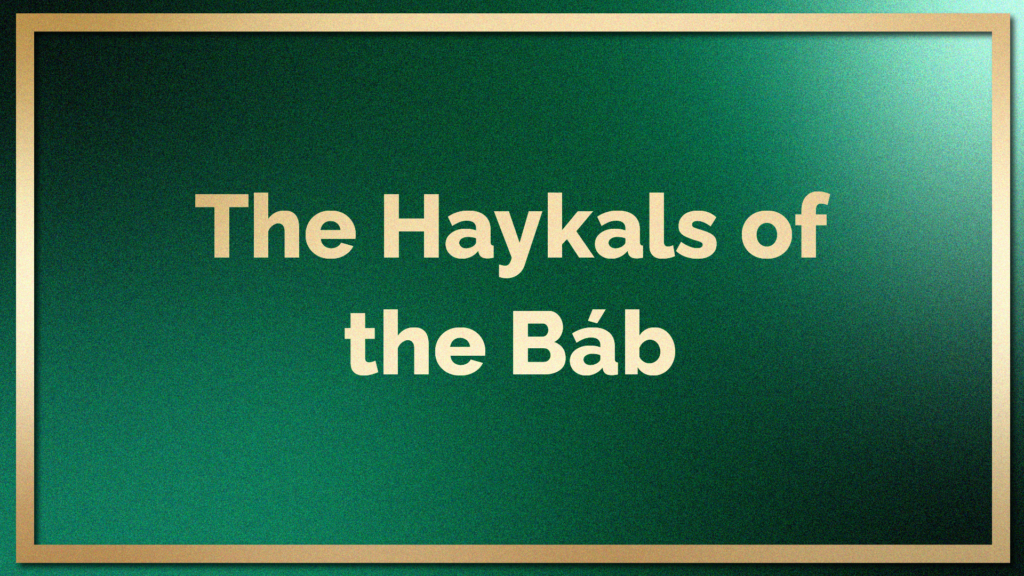

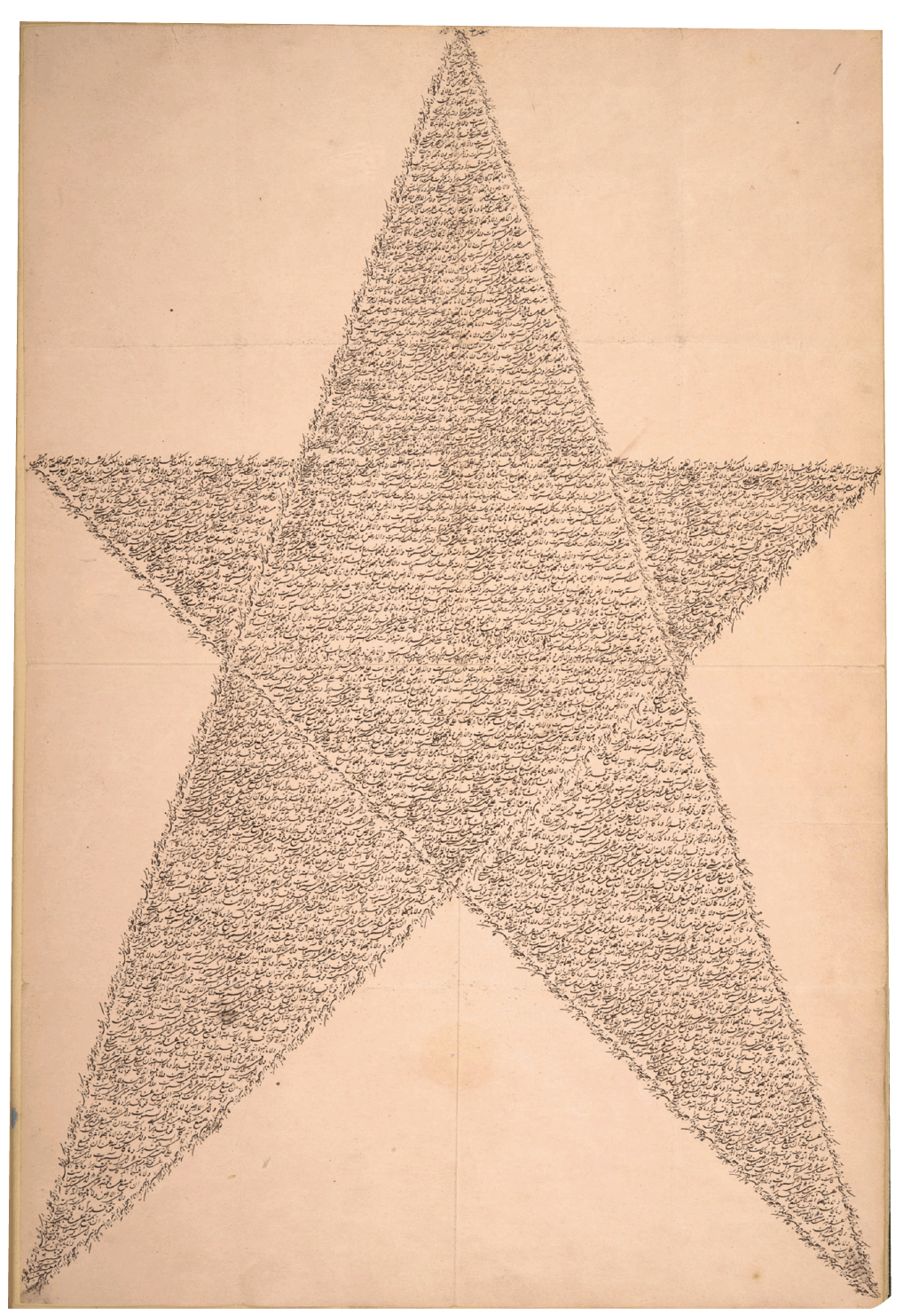
Haykal in the Báb’s own handwriting, Partial Inventory ID: BB00126. Source: British Library.
In the next section is a description of an exquisite work of calligraphy by the Báb, enclosed among His possessions as a last gift to Bahá'u'lláh, Whose Advent He had prepared for the six years of His Dispensation.
At this juncture, it is only right to dwell for a short time on these works of calligraphy the Báb created, truly extraordinary works of art created by a Manifestation of God, something unique in the recorded history of religion.
We are deeply fortunate to have many samples of the Báb’s art works that exist, and this section is an attempt to shed light on their significance and explain their meaning.
Several of the Báb’s calligraphy artworks are in the shape of a five-pointed star, called a haykal in Persian. The word haykal can also mean temple, because the shape is meant to represent a highly stylized version of the human temple: the head, two arms and two legs of the human body.
In the Persian Bayán, the Báb explains that the intersecting lines of the five-pointed haykal create six spaces, or chambers inside the shape: 5 is the numerical value of the letter H, and 6 is the numerical value of the letter W. Together, these two vowels spell the word Huwa, meaning “He,” a reference to God in mystical Islamic literature. The letters composing the Báb’s name B, A, and B, also have a numerical value of 5.
The Báb also explains that the structure of the haykal is made of five outer, visible lines, representing the visible Manifestation of God (Báb = 5), and the six inner, hidden chambers, representing the Unknowable essence of God (Huwa = 6). In this analysis, the haykal represents something beyond the human temple, it is a mystical reflection of a tangible, visible Manifestation of God, manifesting the unknowable, hidden essence of God.
Haykals were designed by the Báb as protective talismans for men to carry, the haykal symbolizing the Perfect Man, or the Manifestation of God (the Báb). For the Báb, these talismans were not meant for physical protection or good luck, but rather for spiritual protection, as a way to guide the thoughts of His followers away from superstition and towards God, in the hopes that when Bahá'u'lláh appeared, they would immediately turn to Him.
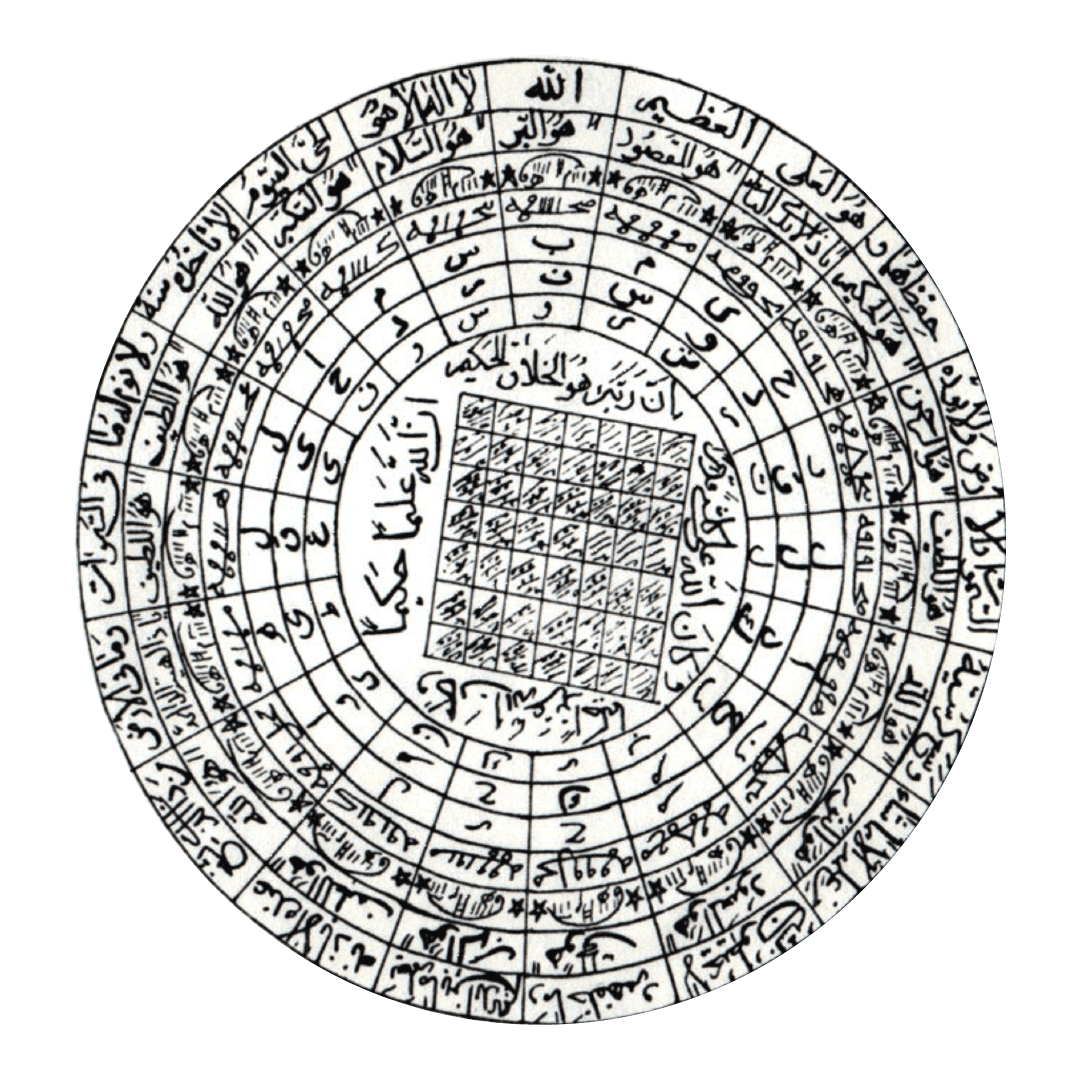
Da’ira, round talisman for women, drawn by the Báb. Source: Bahá'í Library Online.
For women, the Báb designed a separate talisman. Instead of a sharp, masculine, five-pointed star, His design for a talisman for women, called a Da'ira, was a series of six concentric circles, again for the letter W, intersected by lines which then provide five spaces in between the concentric circles, five for the value of the letter H, in which to write verses form the Holy Writings. This symbol, according to the Báb, represents the Sun of Truth, a representation of the Manifestation of God (the Báb).
In the Persian Bayán, the Báb states that the six chambers of the pentagram for men, and the five chambers of the concentric circles for women should be filled witih verses, but He leaves the choices of the verses up to the artist.
His wish was that those who wore the talismans would come to embody the Divine attributes contained in the passages from His writings, and refers to men and women the Bayán as “possessors of the pentagram” and “possessors of the circle,” not defining them by their talismans, but rather by the Manifestation of the Names and Attributes of God enshrined within the heart of each individual.
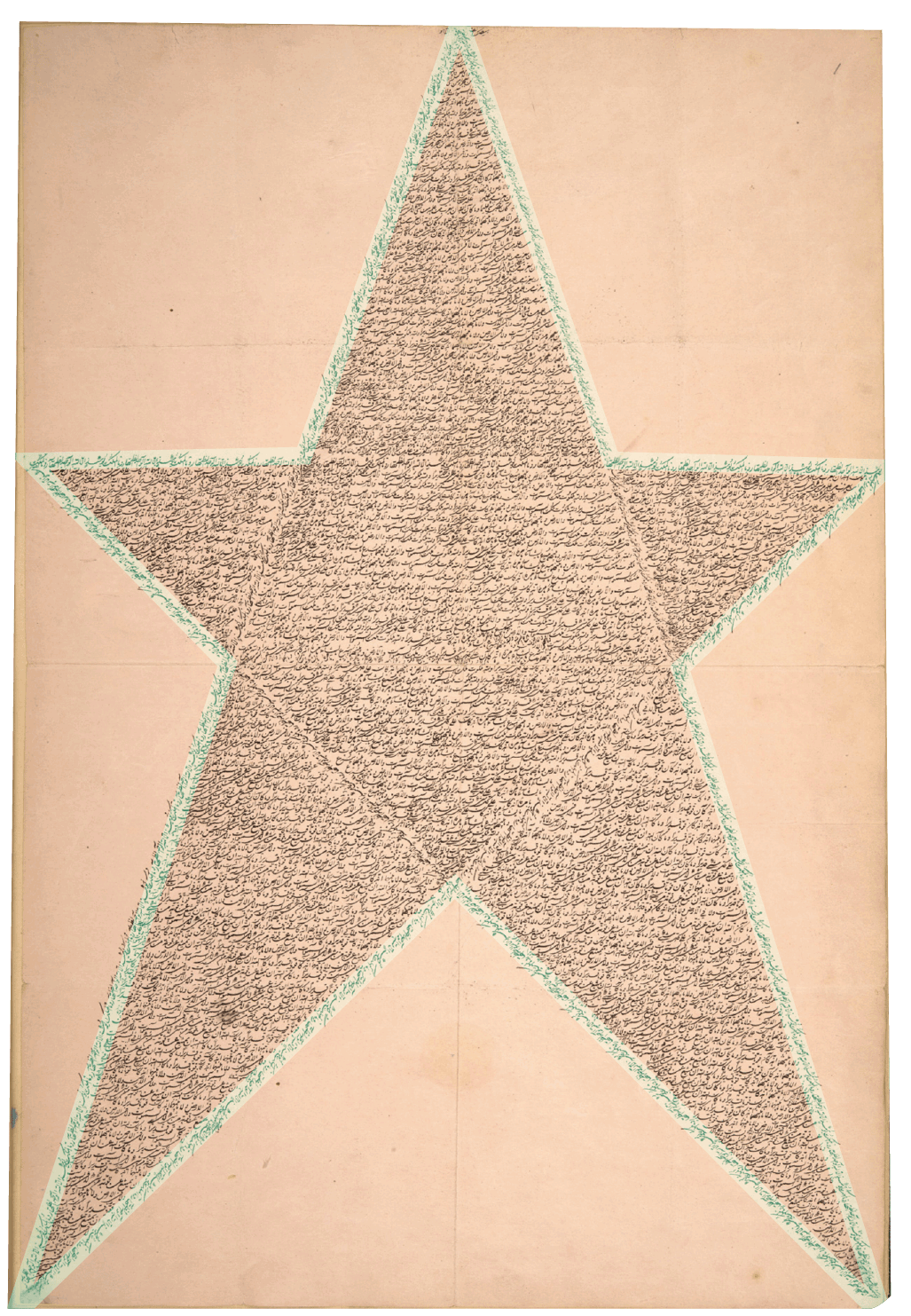
Graphic of the verse forming the outline of the Haykal. Design of the graphic: © Violetta Zein
The sublime haykal in the hand of the Báb in the collection of the British Library, is undated and we have no information on the addressee, but Dr. Moojan Momen believes it may have been penned towards in the last three years of the Báb’s life because of similarities in the phrasing with two works from that period: the Kitáb-al ‘Asmá’ and the Seven Proofs.
The structure of this haykal is deeply intricate, as it consist of repetitions of short, rhyming, rhythmical verses, intended to be chanted, not read silently. All the verses are in praise of God, and the section is a highly summarized version of the quoted paper, but is offered here, at the end of the Báb’s life as a celebration of His peerless qualities as a calligrapher, and a testament to the resilience of His spirit.
That the Báb could, at the end of His short life, so filled with agony and suffering, create something so delicate and beautiful in praise of the God He was soon to return to, and create such a thoughtful, intricate piece of art in such a barren, desolate place, is a deeply touching vignette of the last years of His life.
The five lines creating the outline of this haykal are formed from a single, repeated verse, a highly significant verse relating to the advent of Bahá'u'lláh:
“On that Day, the Kingdom shall be God’s, the Incomparable, the Most Manifest.”
This verse is repeated a total of 95 times along the five lines which create the outline of the haykal, a different number of times along each line (you can obtain further details on this in the presentation by Dergham Aqiqi and Todd Lawson linked below).
Partial Inventory ID: BB00126
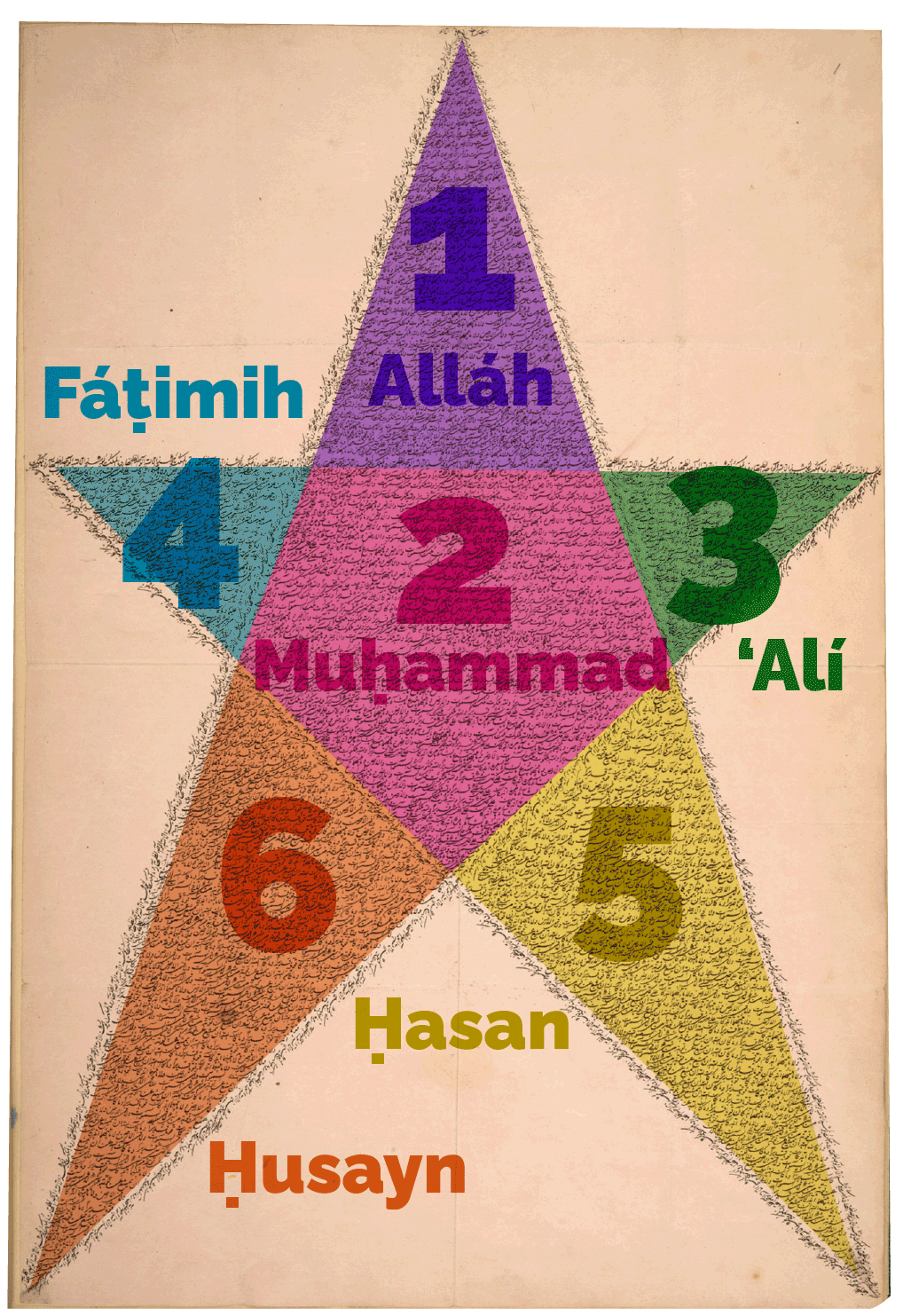
Graphic of the six central sections of the Haykal. Design of the graphic: © Violetta Zein
Starting from the top, these are the six inner sections of the haykal, according to the Báb:
- The first, topmost inner section is called Alláh;
- The second central, inner section is Muḥammad;
- The third section, on the right, is called ‘Alí;
- The fourth section on the left is Fáṭimih;
- The fifth, bottom left section, is Ḥasan;
- And the sixth section on the bottom left is Ḥusayn.
The first section, Alláh, is filled with 1 to 12 repetitions of 7 different verses, the most repeated one being:
“And to God belongs the kingdom of the sovereignty of the heavens and the earth and whatever is between them. There is no weakness in Him regarding anything, neither in the heavens nor in the earth nor beyond whatever is between them. Verily He is utterly powerful over all created things.”
The second, central or inner section, Muḥammad, contains one verse, repeated 4 times and this second verse repeated 55 times, and the name of the Prophet Muḥammad appears three times:
“Indeed, to God belongs the kingdom of the sovereignty of the heavens and the earth and whatever is between them. He originates from nothing whatever He wishes through His command. Verily He is utterly powerful over everything.”
The third section, ‘Alí, also has three occurrences of the name ‘Alí, and is composed of 8 different verses, repeated between 1 and 3 times.
The fourth section, Fáṭimih, where the name Fáṭimih appears 3 times, is composed of 2 verses, repeated 5 and 6 times.
The fifth section, Ḥasan, repeats the name Ḥasan 4 times, and is composed of 2 verses, repeated 8 and 31 times.
The sixth section, Ḥusayn, repeats the name Ḥusayn 4 times, and contains one verse, repeated 41 times:
“Indeed, God is He Whom no created thing, neither in the heavens nor in the earth nor whatever is beyond them, can ever withstand his strength. Verily, He is Strong, Powerful.”
Partial Inventory ID: BB00126

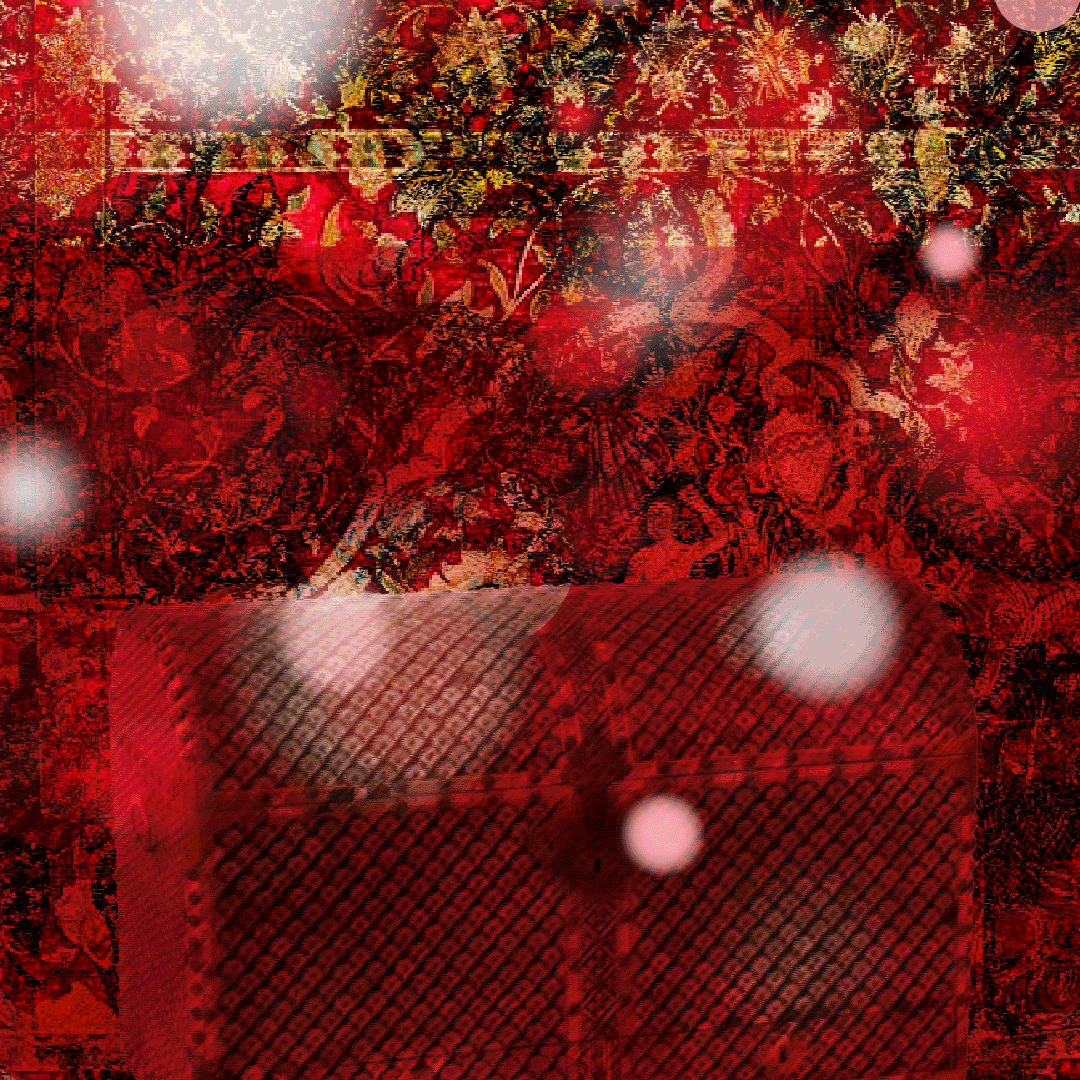
“The coffer”: NOTE: This is NOT the coffer with the belongings of the Báb. Artistic interpretation of the priceless coffer of the Báb’s belongings which He sent to Bahá'u'lláh, 40 days before His martyrdom. Antique Persian coffer on a background of two museum-quality Persian carpets, superimposed on one another. Source of image: 18th century Persian bridal coffer from the National Museum of Ireland.
Forty days before His martyrdom, keenly aware that the end of His life was fast approaching its end, the Báb placed all His Writings, His pen-case, His seals and rings in a box which He entrusted to Mullá Báqir-i-Tabrízí, the Thirteenth Letter of the Living, with instructions to deliver it, along with a letter, to Mírzá Aḥmad-i-Kátib.
Mullá Báqir left Chihríq and arrived in Qazvín 18 days later. When he arrived, he learned Mírzá Aḥmad had already left Qazvín for Qum so he immediately followed him there and arrived sometime in the middle of June 1850.
In Qum, Mullá Báqir and Mírzá Aḥmad shared a house with a number of other Bábís, and when Mullá Báqir opened the box entrusted to him by the Báb, they were amazed at what they found.
In addition to the Writings of the Báb, His pen-case and His seals, the Báb had placed a scroll of the most delicate blue paper, entirely spotless, on which He had calligraphed, in His exquisite shikastih penmanship, 360 derivatives of the word “Bahá” in the shape of a five-pointed star. Viewed from a distance, the Báb’s calligraphy was so intricate that the pentacle seemed to have been colored with a single wash of ink on paper, individual letters could not be distinguished.
It was a masterpiece no calligraphist could hope to rival.
They replaced the scroll in the coffer, and gave it back to Mírzá Aḥmad, who, upon receiving it, left for Ṭihrán to give it to Bahá'u'lláh.
The Báb had been in constant touch with Bahá'u'lláh during His ministry, and the last Tablets He addressed to Him, the Báb addressed Him repeatedly as “Him Whom God shall make Manifest."
REFERENCES FOR PART XI
REVELATION: Early August 1848, Chihríq: Khuṭbiy-i-Qahríyyih (The Sermon of Wrath)
H.M. Balyuzi, The Báb: The Herald of the Day of Days, page 149.
Fereydun Vahman (Editor),The Bab and the Babi Community of Iran (2020), Chapter 1: The Báb: A Sun in a Night Not Followed by Dawn by Fereydun Vahman.
Mírzá ‘Alíy-i-Sayyaḥ (Traveller): The faithful courrier of the Báb
H.M. Balyuzi, The Báb: The Herald of the Day of Days, pages 148-149.
After August 1848: The story of Anís
H.M. Balyuzi, The Báb: The Herald of the Day of Days, pages 153-154.
4 September 1848: One despot dies, another one ascends the throne
H.M. Balyuzi, The Báb: The Herald of the Day of Days, page 148.
REVELATION: Tablet to Mullá Báqir
Nader Saiedi, Gate of the Heart: Understanding the Writings of the Báb, pages 36, 351, and 371-373.
REVELATION: December 1848 – January 1849: Kitáb-i-Sí Du’á (The Book of Thirty Prayers)
Nader Saiedi, The Ethiopian King, translated by Omid Ghaemmaghami published in Baha’i Studies Review, Volume 17.
Around 30 March 1849: Ḥájí Mírzá Siyyid ‘Alí visits the Báb in Chihríq
H.M. Balyuzi, The Báb: The Herald of the Day of Days, page 150.
DATE
The letter from Ḥájí Mírzá Siyyid ‘Alí was dated the fifth day of Jamádíu’l-Úlá. In 1848, that day corresponded to 20 march 1849. Source: Habibur.com: Islamic Hijri Calendar For Jumada al-awwal – 1265 Hijri.
REVELATION: Late 1849: The Badí’ calendar
Stephen Lambden, The Kitab al-asma’ (Book of Names) or Chahar ShaN° (The [Book of the] Four Modes [of Revelation]) of Sayyid `Ali Muhammad, the Bab (d. Tabriz 1850).
John Taylor, Novelty in Ayyám-i-Há and the Badí Calendar.
Nader Saiedi, Gate of the Heart: Understanding the Writings of the Báb, pages 327-328.
Many thanks to Adib Masumian for providing the opening words of the Persian Bayán, their transliteration and their translation into English.
End of June 1849: The Báb learns about the massacre at Shaykh Ṭabarsí
H.M. Balyuzi, The Báb: The Herald of the Day of Days, pages 150-151.
Nabil, The Dawn-Breakers, Chapter XXI: The Seven Martyrs of Ṭihrán.
Shoghi Effendi, God Passes By.
June – October 1849: Five months of heartbreak for the Báb
H.M. Balyuzi, The Báb: The Herald of the Day of Days, pages 150-151.
Nabil, The Dawn-Breakers, Chapter XXI: The Seven Martyrs of Ṭihrán.
Shoghi Effendi, God Passes By.
REVELATION: End of November 1849: Tablet of Visitation for Mullá Ḥusayn
Nabil, The Dawn-Breakers, Chapter XXI: The Seven Martyrs of Ṭihrán.
Nabil, The DH.M. Balyuzi, The Báb: The Herald of the Day of Days, pages 182-185.
Nabil, The Dawn-Breakers, pages 447-448.
February 1850: The Seven Martyrs of Ṭihrán
Bahá’í Library Online: Tag: Báb, life of.
Nabil, The Dawn-Breakers, Chapter XX: The Mázindarán Upheaval (Continued).
Nabil, The Dawn-Breakers, Chapter XXI: The Seven Martyrs of Ṭihrán.
REVELATION: 19 March 1850: Kitáb-i-Panj-Sha’n (The Book of Five Modes)
Shoghi Effendi, God Passes By.
Shoghi Effendi, God Passes By.
Nabil, The Dawn-Breakers, pages 444-445.
David Merrick (compiler), Declaration of the Báb.
Nader Saiedi, Gate of the Heart: Understanding the Writings of the Báb, pages 36 and 41-44.
Wikipedia: Bahá’í calendar.
John Walbridge, The Bab’s Panj Sha’n (Five Modes), published in Research Notes in Shaykhi, Babi and Baha’i Studies,Vol. 2, no. 3 (April 1998).
The sublime pentacles of the Báb
Partial Inventory ID: BB00126
Moojan Momen, The British Library Asian and African Studies Blog: The Star Tablet of the Báb, 29 October 2019.
Moojan Momen, The British Library Asian and African Studies Blog: The Star Tablet of the Báb, 29 October 2019.
The intricate calligraphy inside the six sections haykal
Moojan Momen, The British Library Asian and African Studies Blog: The Star Tablet of the Báb, 29 October 2019.
Dergham Aqiqi and Todd Lawson, Haykal or “Star Tablet ”written in the Báb’s own hand (British Library Manuscript: BL Or 6887): Form, Content and Provisional Translation, (9 November 2021), an updated version of a 29 August 2021 presentation.
Mid-April 1850: The Báb collects all His possessions
H.M. Balyuzi, The Báb: The Herald of the Day of Days, pages 151-152.
 REVELATION: October 1848, Chihríq: Khuṭbiy-i-Qahríyyih (The Sermon of Wrath)
REVELATION: October 1848, Chihríq: Khuṭbiy-i-Qahríyyih (The Sermon of Wrath)
